Salon des Refusés
Part of 'Witch Hunt' @ Kunsthal Charlottenborg, Copenhagen, US
Curated by Jeppe Ugelvig and Alison Karasyk
07.11.2020 - 17.01.2021
To Rasmus Myrup, the folkloric figure of the witch relates to many other beings from Danish folklore who, in legends, were similarly portrayed as a detriment to the establishment; malignant, threatening and weird. These Othered figures, often related to animism, were understood as being closer to nature and as standing opposition to normative human culture. While many of these have been largely forgotten or transposed, the folklore pertaining to the witch still holds a central place in Danish folk tradition, as she is literally re-created annually, rendered in clothes and hay, only to be burned on the stake around the time of Summer Solstice
As an act of reclamation, Myrup’s new commission for Witch Hunt gathers many of these outcast characters in a salon environment, fashioning them as modern individuals. Using the traditional form of the Solstice witch, each figure’s body is created from natural material and dressed in distinct outfits, and their bodies are made from a natural material, each figure embodying a different piece of the Danish nature. In this imagined community of rejects, folkloric characters from ancient times, over norse mythology to pagan 17th-century legends, gather in a utopian nocturnal banquet, resembling a nightclub or bar: A safe space for the witch.
The idea of the witches’ gathering – the sabbath – as a space of animistic transformation, bacchanalia, and sexual debauchery was widely perpetuated during the Nordic witch-hunts, and drew from classic Greek and Roman literature as well pre-Christian shamanic traditions native to the European continent. Often referred to as “the dance,” sabbaths were liminal spaces that inverted normative gender and moral categorization, and were popularly imagined as both threatening and highly alluring, as evident in artistic depictions of the time. By producing a fantastical space for those excluded from the narrative of a modern, human Denmark, Myrup reflects upon our social and political relationship to folklore, and its potential for re-interpretation in the present.
Click here to see the plan of the sculptures in English
Click here to see the plan of the sculptures in Danish
All documentation by David Stjernholm
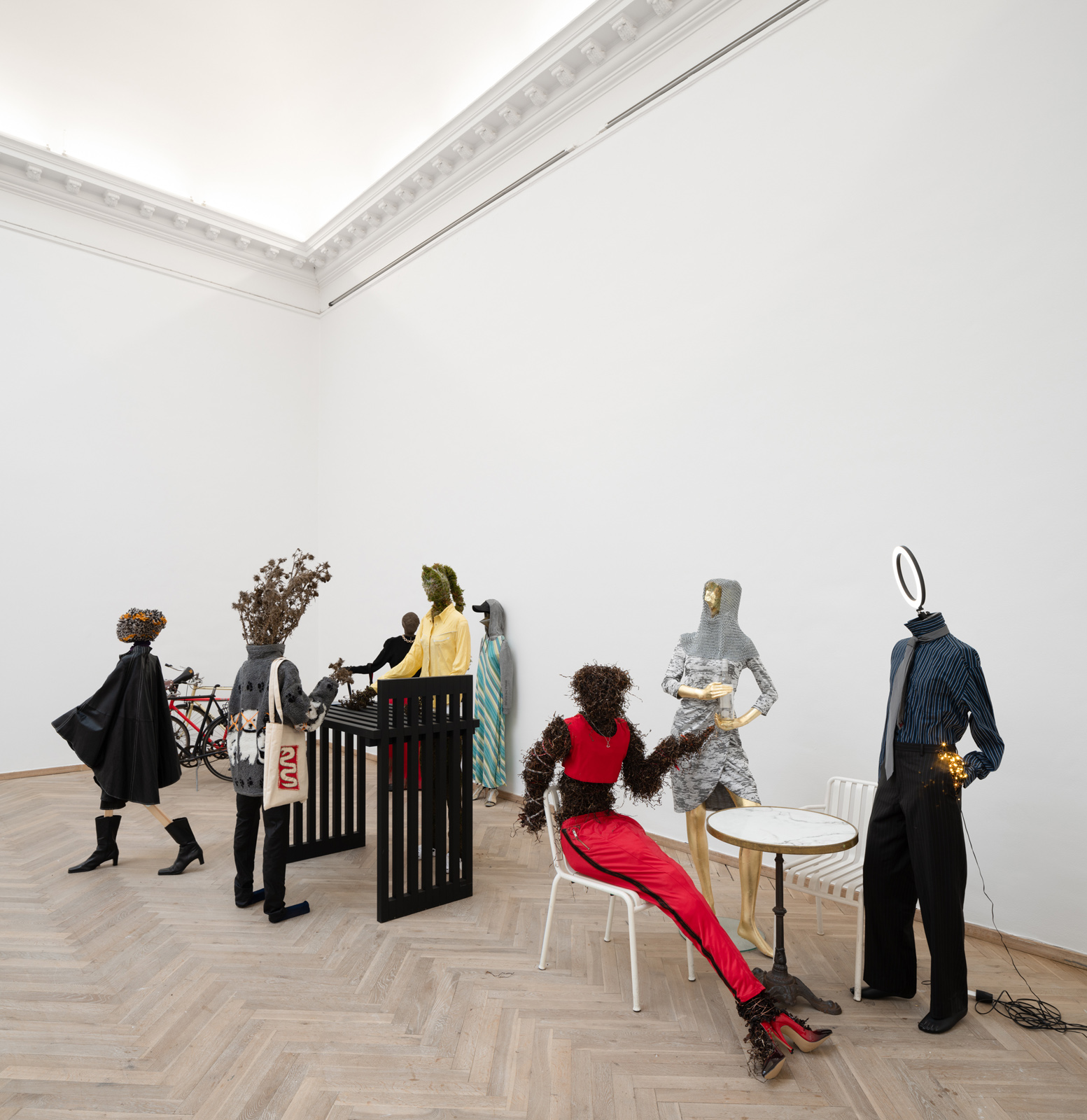
Salon des Refusés, 2020
Installation with clothes and natural materials
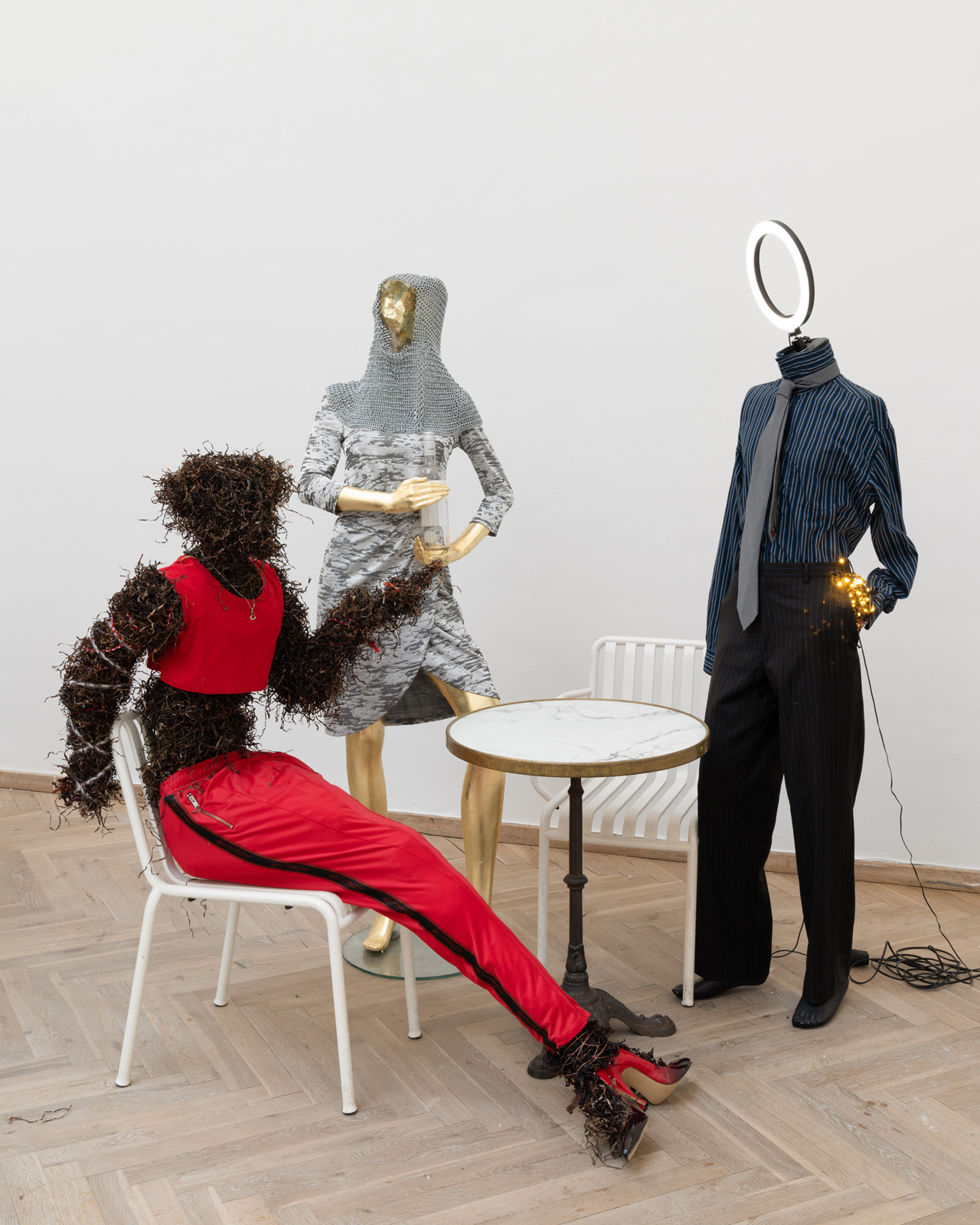
From left to right
Mermaid [Havfrue], 2020
Dried eel grass, wound wool, copper wire, joint mermaid pants, crop top, cigarette, necklace, joint pair of high heels, wooden structure
Gullveig, 2020
Mannequin, laquered gold leaf, dress, chainmail hood, rock, wine bottle
Latern man [Lygtemand], 2020
Mannequin, Ring light, chained lights, copper wire, shirt, pants, tie, plugs
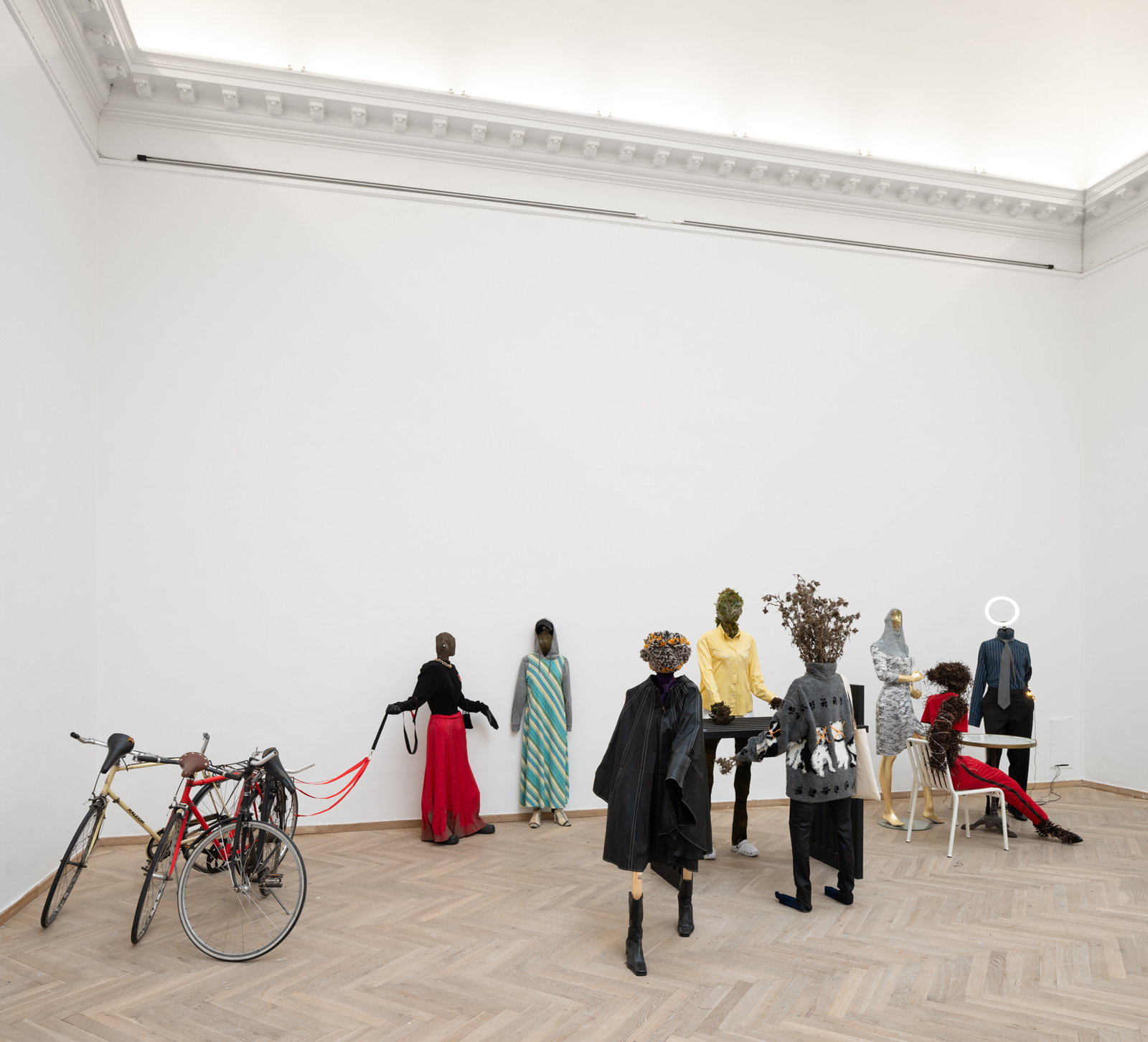
Salon des Refusés, 2020
Installation with clothes and natural materials
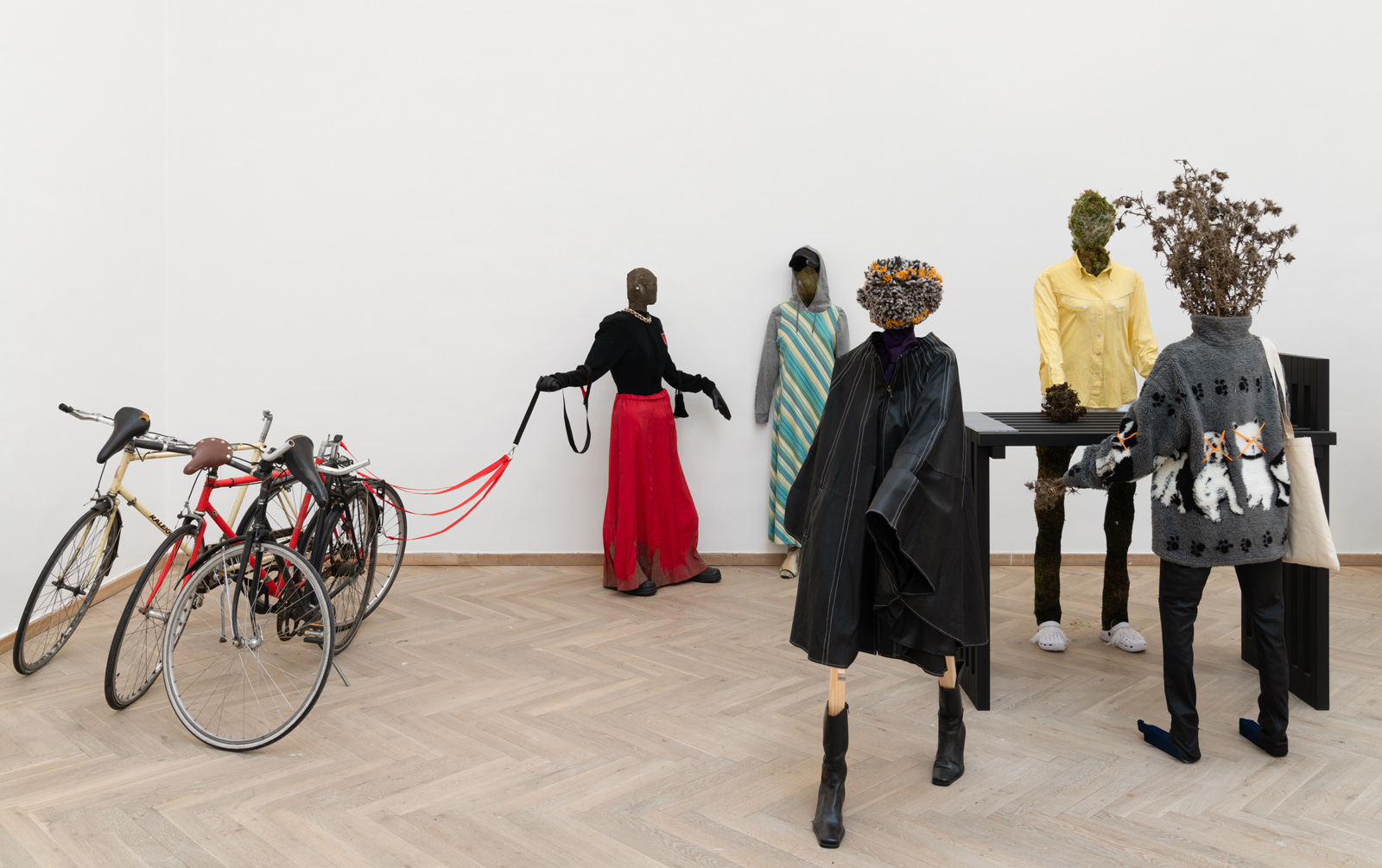
From left to right
Shield Cubs [Skjolungerne] and Gefion, 2020
Reconfigured bikes, harness, soil from Lejre (DK), wooden structure, foam, gloves, pins, sweater with embroidery, soiled skirt, boots, necklace, ear rings, hand bag
Lakemaid [Søfrue], 2020
Lake water from Gråmyr, Gudhjem (DK), plastic bags, Cast hoodie w/ cap, silk dress, shoes
Maren Splid, 2020
Wool, wooden structure, tie, scarf, cape, boots
Bog Lady [Mosekonen], 2020
Moss, dried withered flowers, mohair wool, cast shirt, pantyhose, shoes w/ feathers, shorts, hair bands
Hyrrokkin, 2020
Dried withered thistles, embroidered sweater, embroidered tote bag, pants, wooden structure, foam, socks, ring
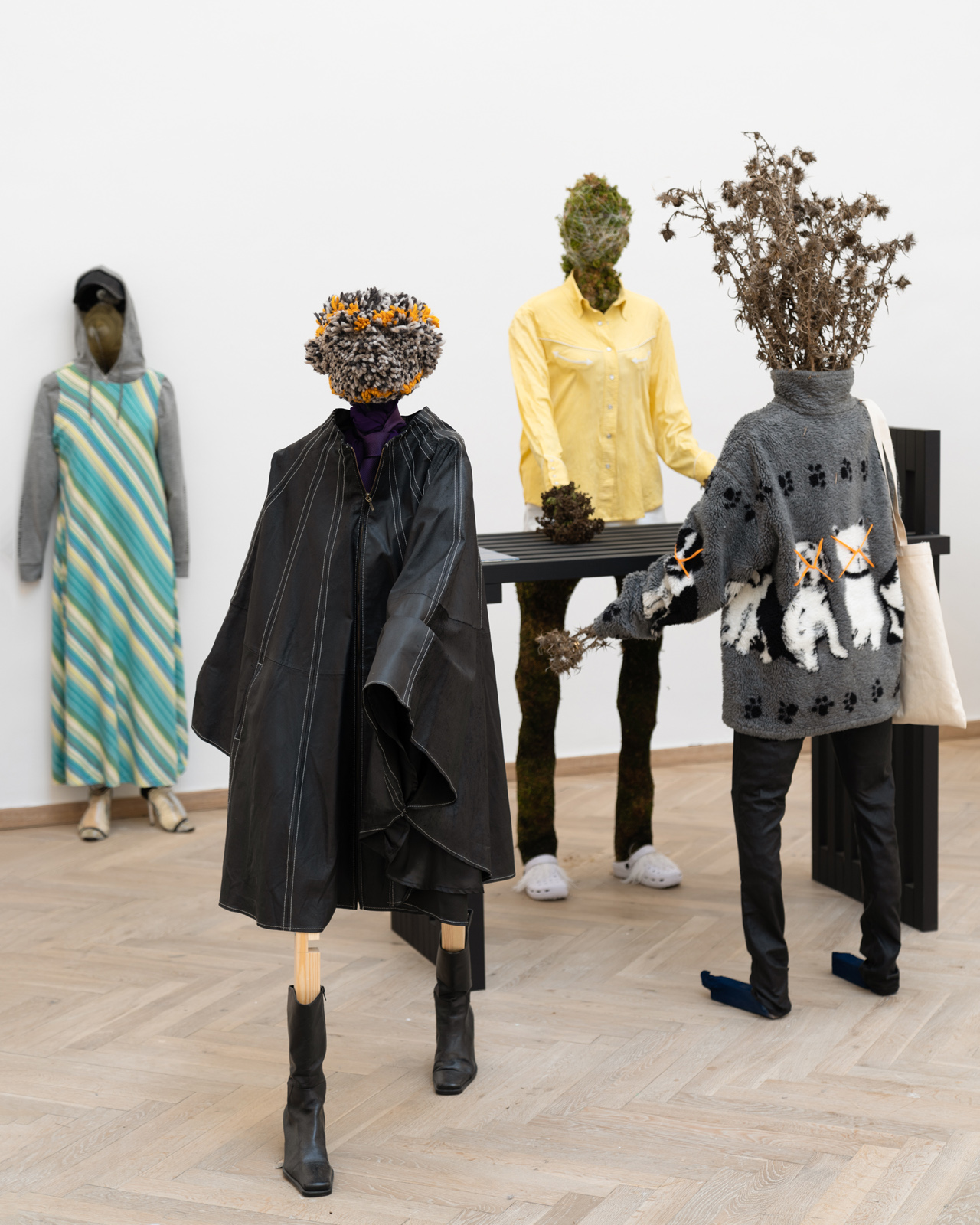
Lakemaid [Søfrue], 2020
Lake water from Gråmyr, Gudhjem (DK), plastic bags, Cast hoodie w/ cap, silk dress, shoes
Maren Splid, 2020
Wool, wooden structure, tie, scarf, cape, boots
Bog Lady [Mosekonen], 2020
Moss, dried withered flowers, mohair wool, cast shirt, pantyhose, shoes w/ feathers, shorts, hair bands
Hyrrokkin, 2020
Dried withered thistles, embroidered sweater, embroidered tote bag, pants, wooden structure, foam, socks, ring
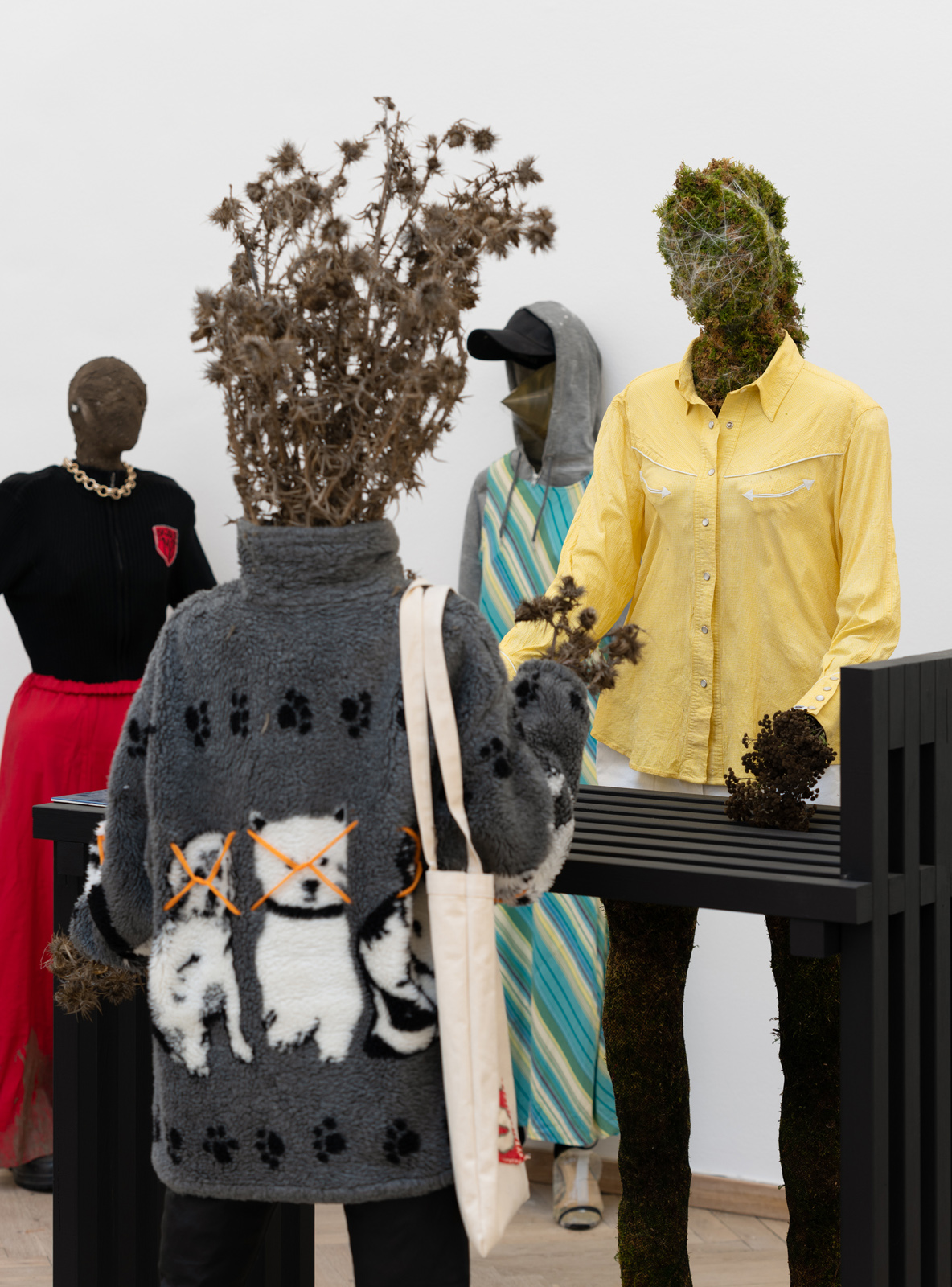
Gefion, 2020
Soil from Lejre (DK), wooden structure, foam, gloves, pins, sweater with embroidery, soiled skirt, boots, necklace, ear rings, hand bag
Hyrrokkin, 2020
Dried withered thistles, embroidered sweater, embroidered tote bag, pants, wooden structure, foam, socks, ring
Lakemaid [Søfrue], 2020
Lake water from Gråmyr, Gudhjem (DK), plastic bags, Cast hoodie w/ cap, silk dress, shoes
Bog Lady [Mosekonen], 2020
Moss, dried withered flowers, mohair wool, cast shirt, pantyhose, shoes w/ feathers, shorts, hair bands
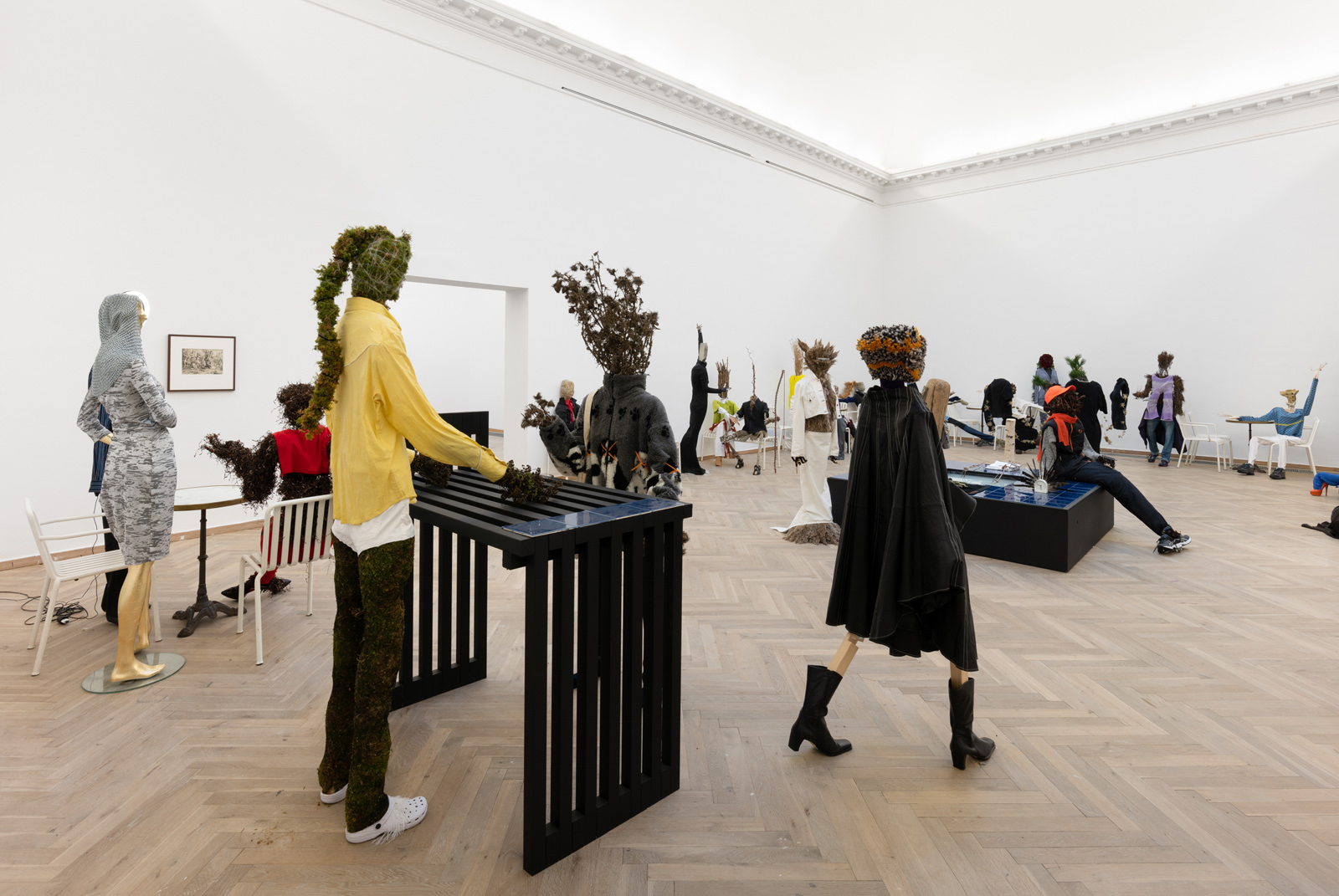
Salon des Refusés, 2020
Installation with clothes and natural materials
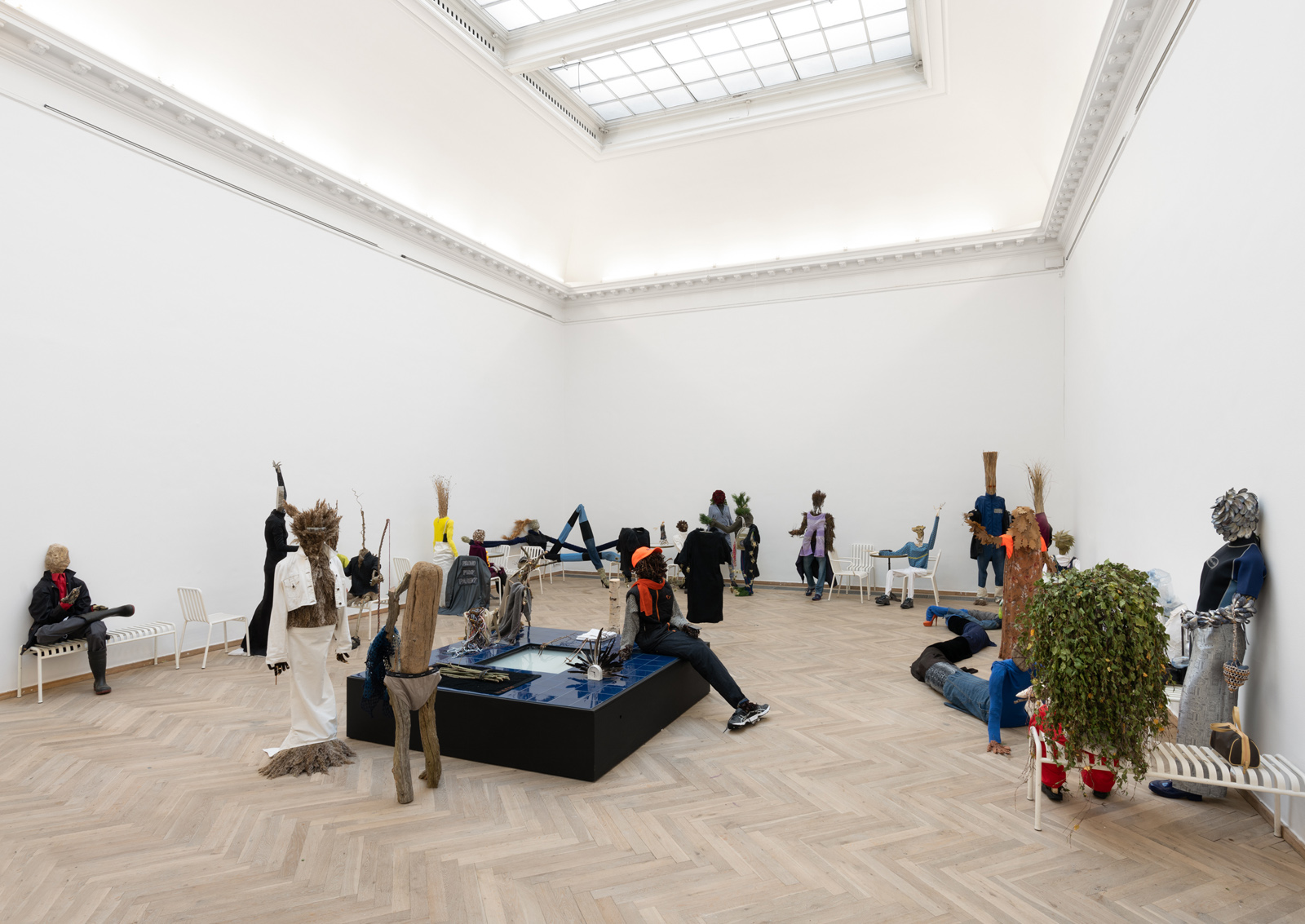
Salon des Refusés, 2020
Installation with clothes and natural materials
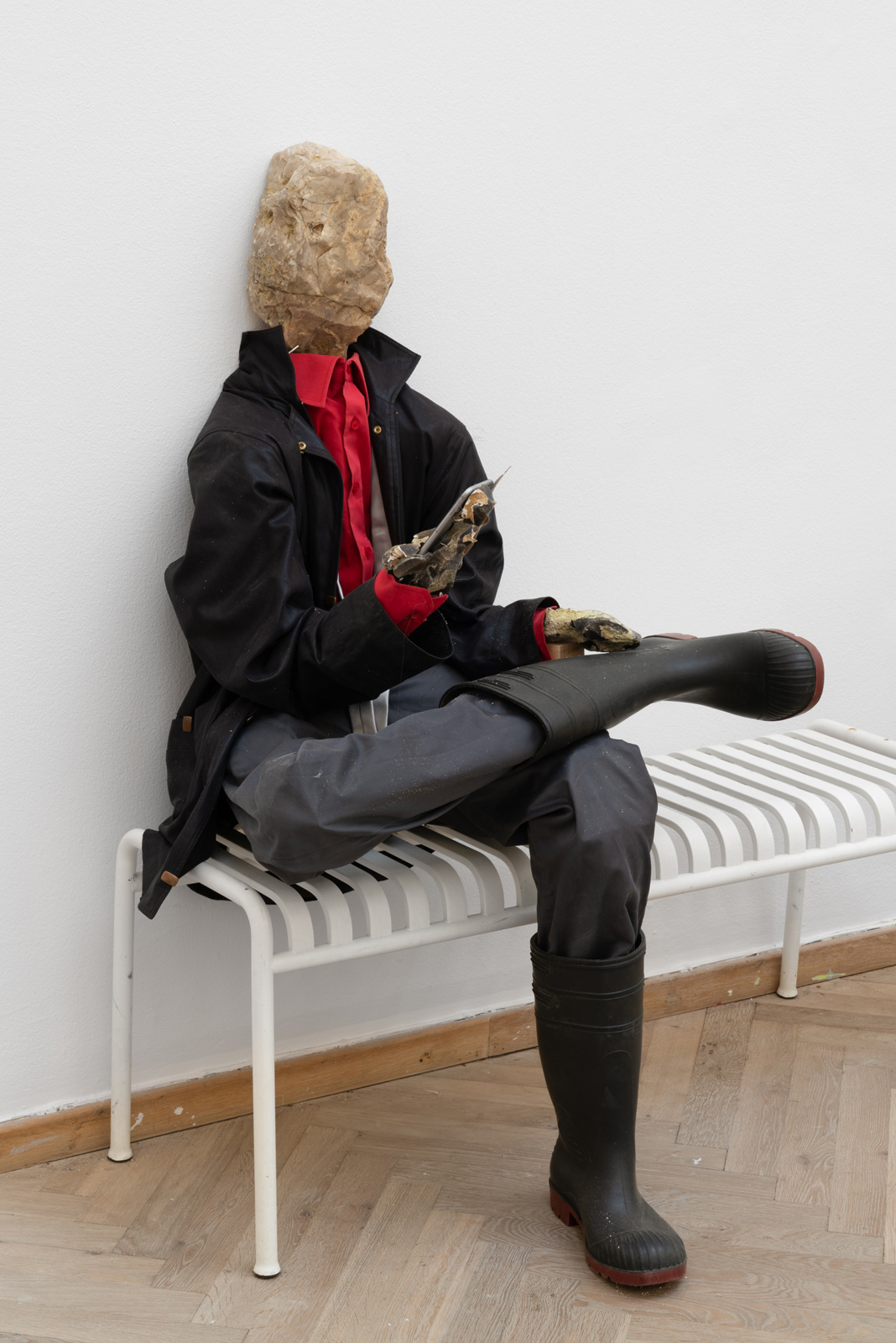
The Night Plower [Nattepløjeren], 2020
Rocks from plowing field in Asnæs (DK), broken phone, wooden structure, shirt, tie, jacket, boots, pants, foam, hardware
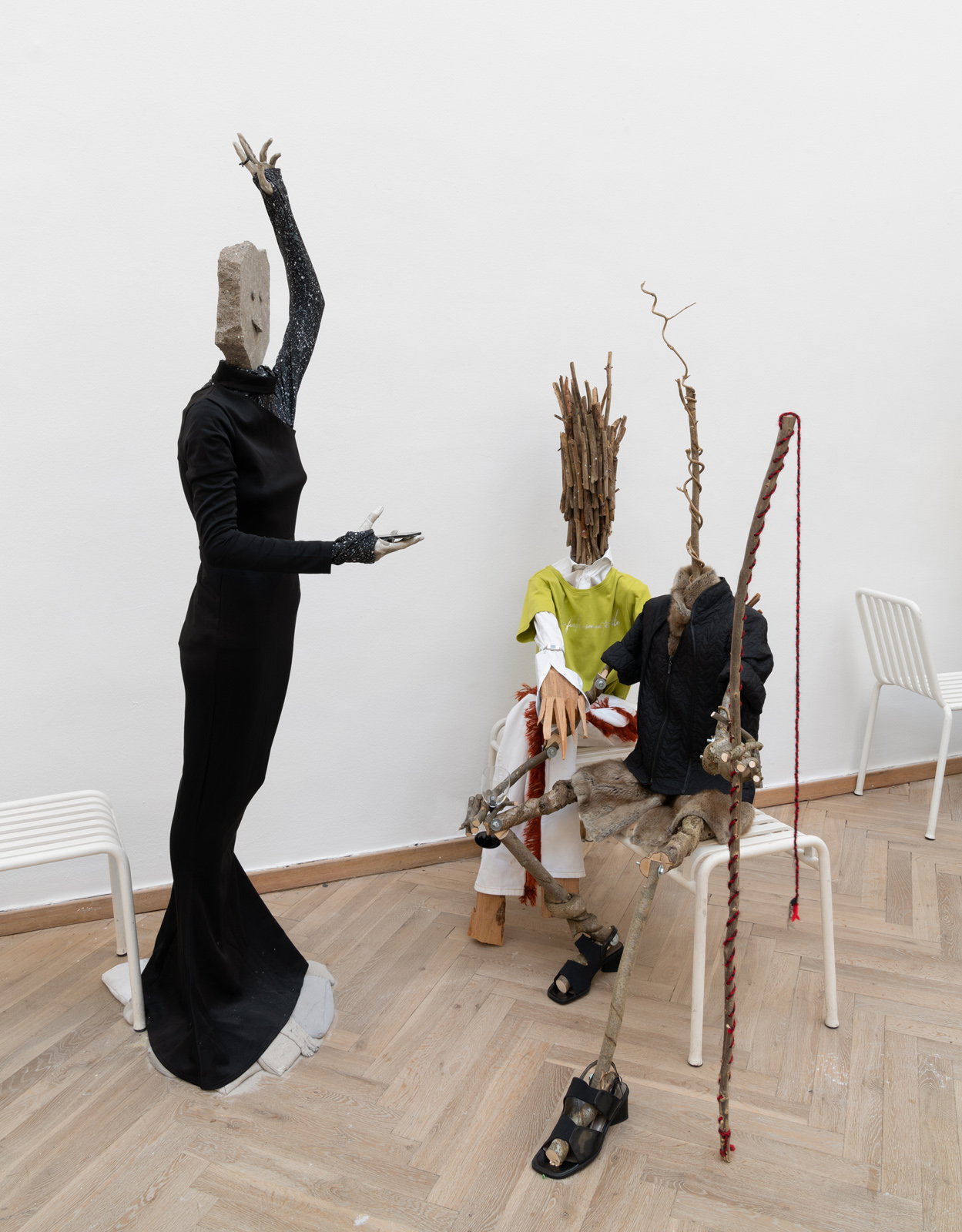
From left to right
The Dyke [Betonlebben], 2020
Concrete, silk sand bags, sand, mannequin, phone, dress, shirt, ring
The Faggot [Bøssen], 2020
Firewood, faggot of pine sticks, pants, shirt, t-shirt, watch, wooden structure
Völva [Vølven], 2020
Wound rowan wood, honeysuckle, repurposed fur, jacket, wound wool, wooden structure, sandals, glass
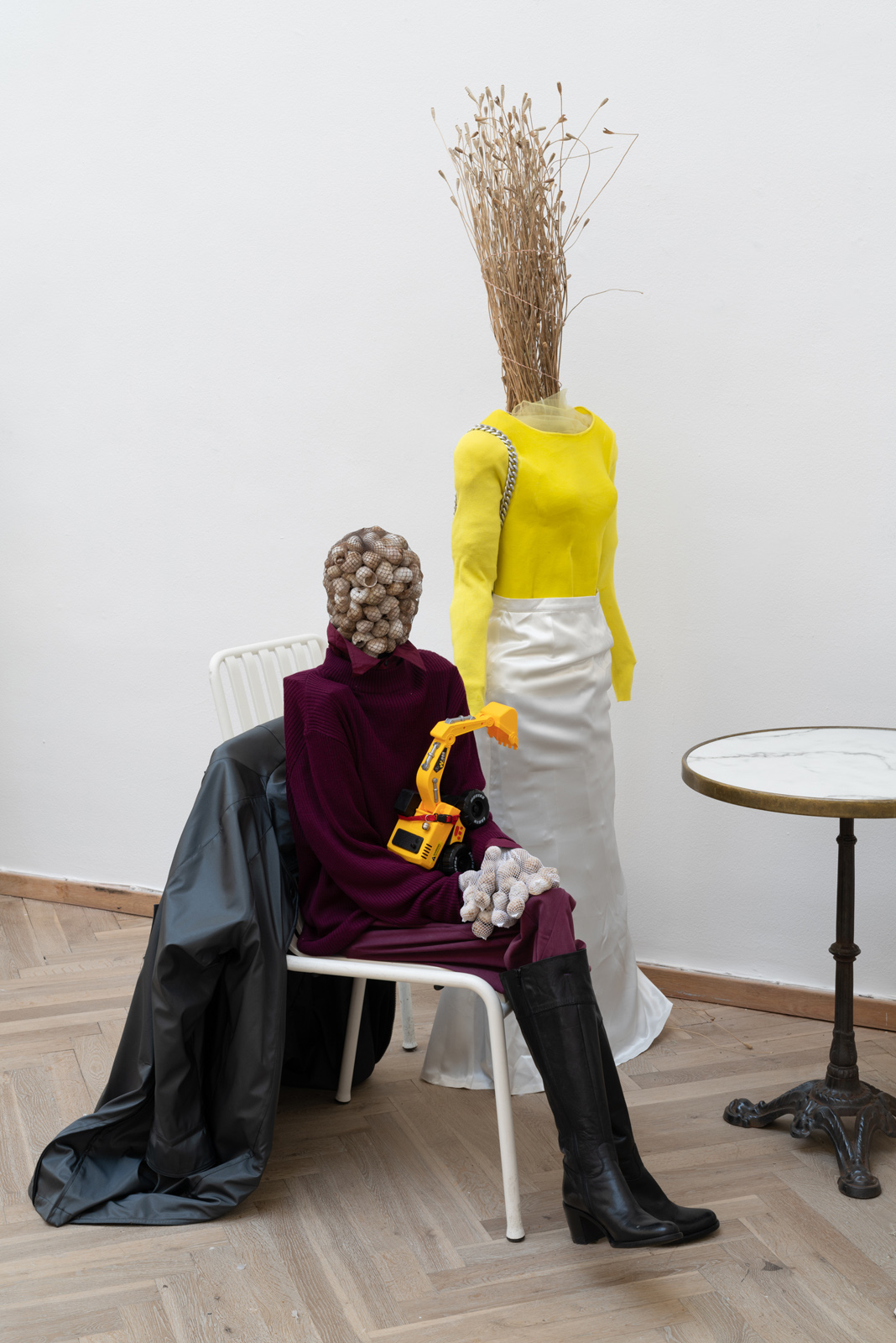
From left to right
Limgrim's Mother and Limgrim, 2020
Snail shells, Pantyhose, gloves, jacket with embriodered patches, shirt, sweater, pants, boots, wooden structure and Toy excavator, cat collar with bell
Tryne's Daughter, 2020
Dried, withered poppies, wound copper and woolen thread, bag with chain, cast sweater, scarf, skirt, wooden structure
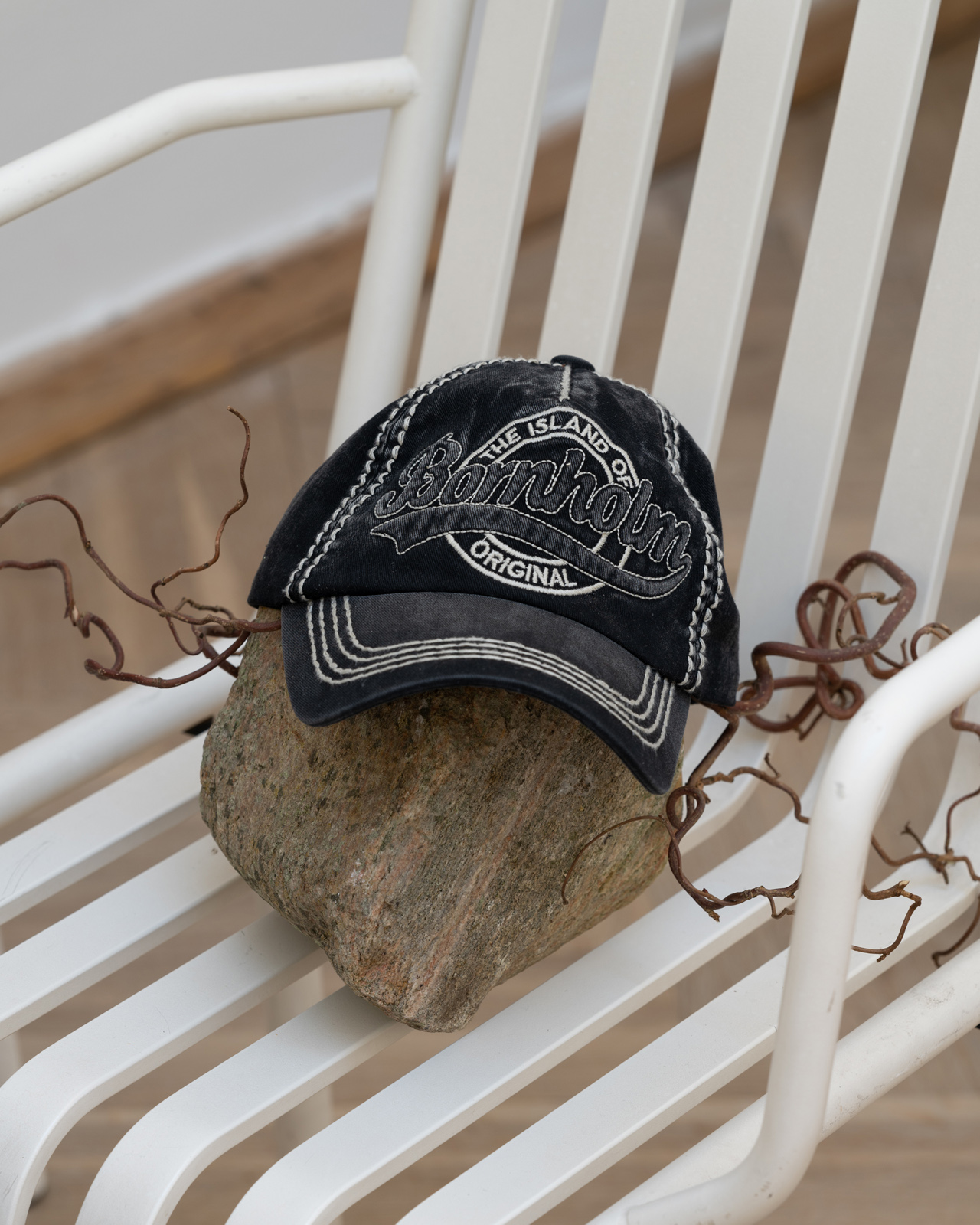
Troll [Krølle Bølle], 2020
Granite rock, cap, Corkscrew hazel [troldhassel]
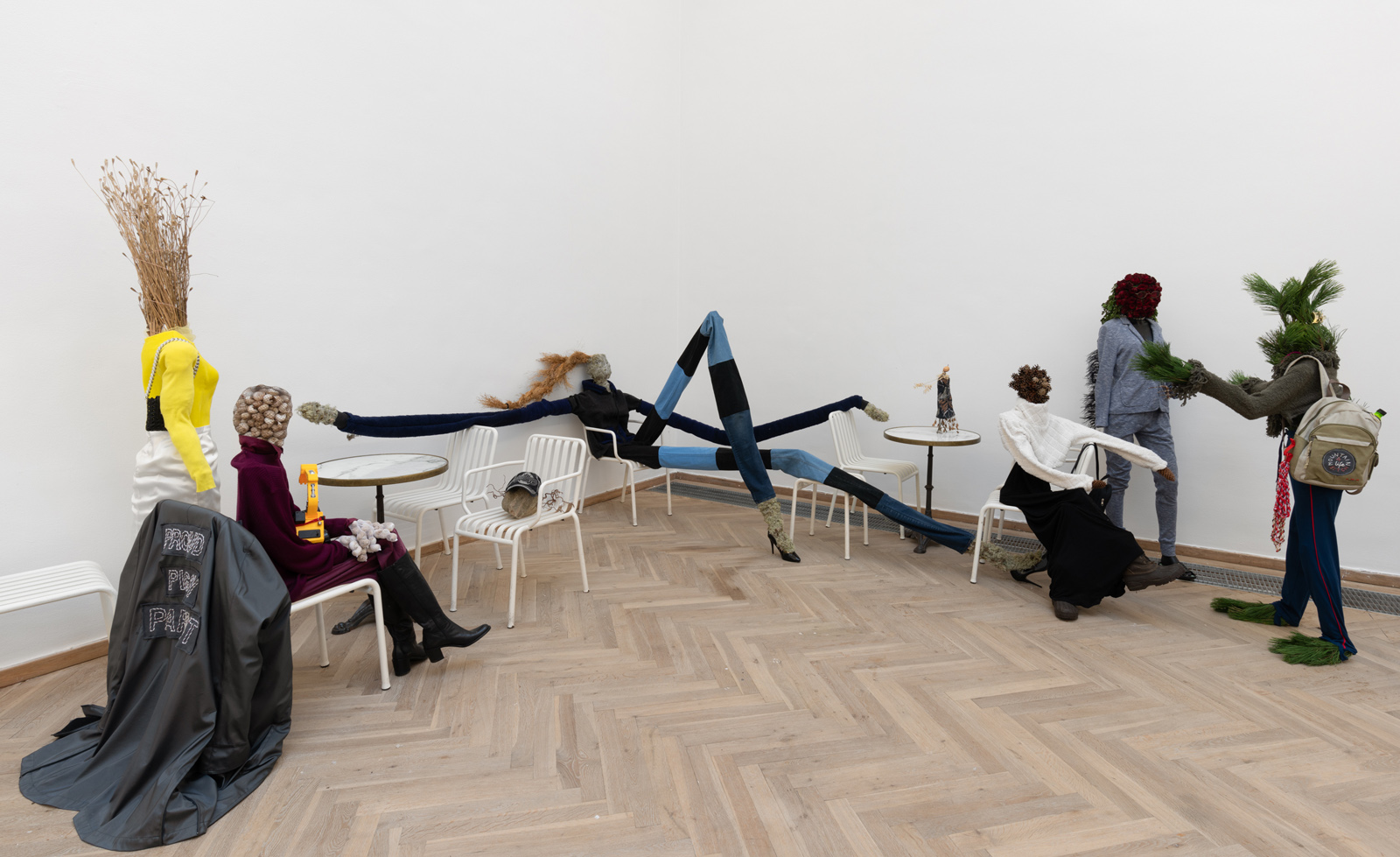
From left to right
Limgrim's Mother and Limgrim, 2020
Snail shells, Pantyhose, gloves, jacket with embriodered patches, shirt, sweater, pants, boots, wooden structure and Toy excavator, cat collar with bell
Tryne's Daughter, 2020
Dried, withered poppies, wound copper and woolen thread, bag with chain, cast sweater, scarf, skirt, wooden structure
Troll [Krølle Bølle], 2020
Granite rock, cap, Corkscrew hazel [troldhassel]
Giant [Kæmpe], 2020
Lichen [Lav], mohair thread, hoodie with elongated sleeves, elongaterd pants, high heels, grass, t-shirt, wooden structure
Gnome [Nisse], 2020
Dried, cut apple, withered flowers, branches, silk dress
Gerd, 2020
Pine cones, fleece shirt, dress, boots, wooden structure
Freya [Freja], 2020
Roses, rose stems, glasses, jersey suit with feather tracks, shoes, necklace, mannequin
Skadi [Skade], 2020
Pine needles, bag with embroidered patch, wound threads, bottle, sweater, bra, pants, hair clip, ring, hardware, wooden structure
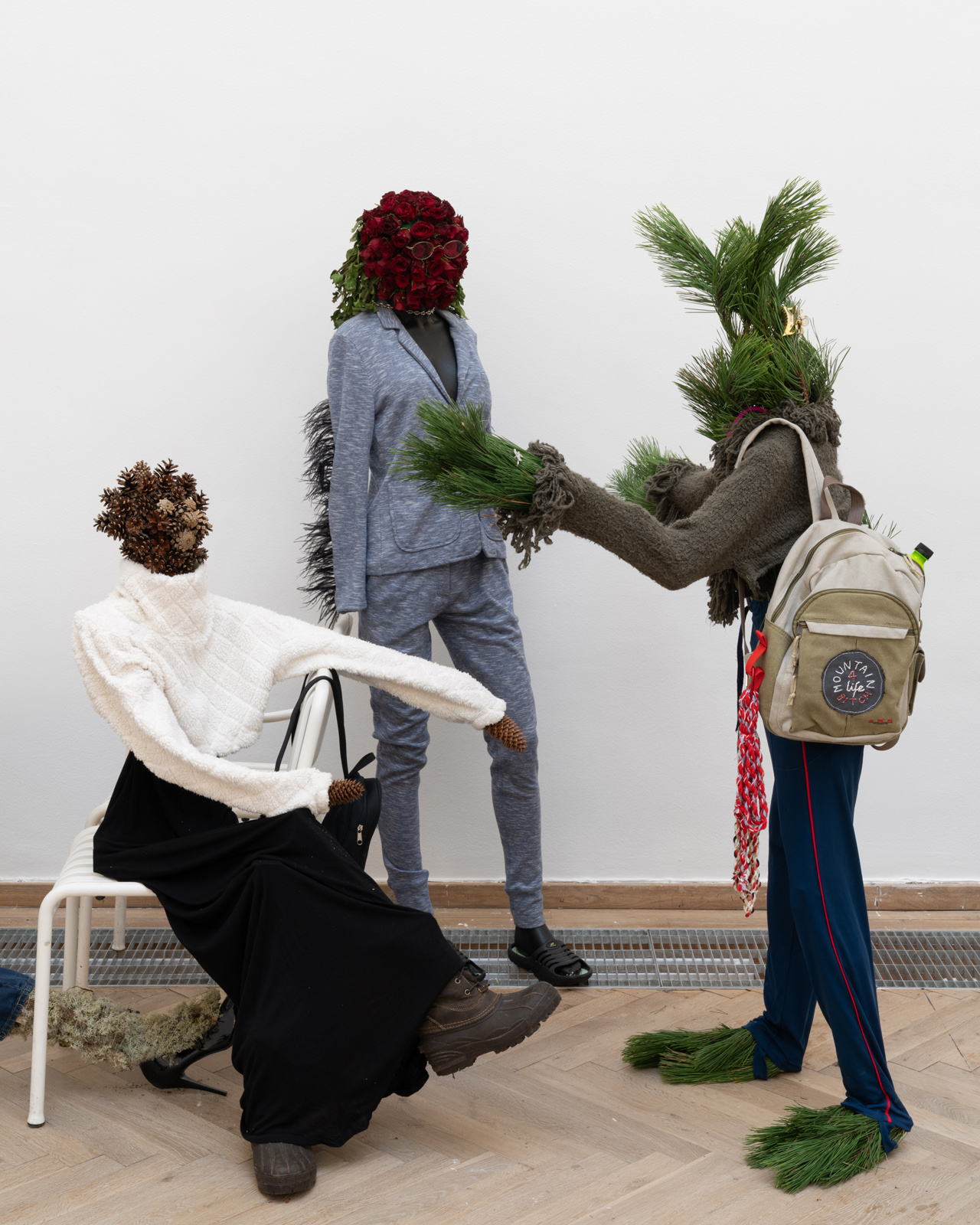
From left to right
Gerd, 2020
Pine cones, fleece shirt, dress, boots, wooden structure
Freya [Freja], 2020
Roses, rose stems, glasses, jersey suit with feather tracks, shoes, necklace, mannequin
Skadi [Skade], 2020
Pine needles, bag with embroidered patch, wound threads, bottle, sweater, bra, pants, hair clip, ring, hardware, wooden structure

Skadi [Skade], 2020
Pine needles, bag with embroidered patch, wound threads, bottle, sweater, bra, pants, hair clip, ring, hardware, wooden structure
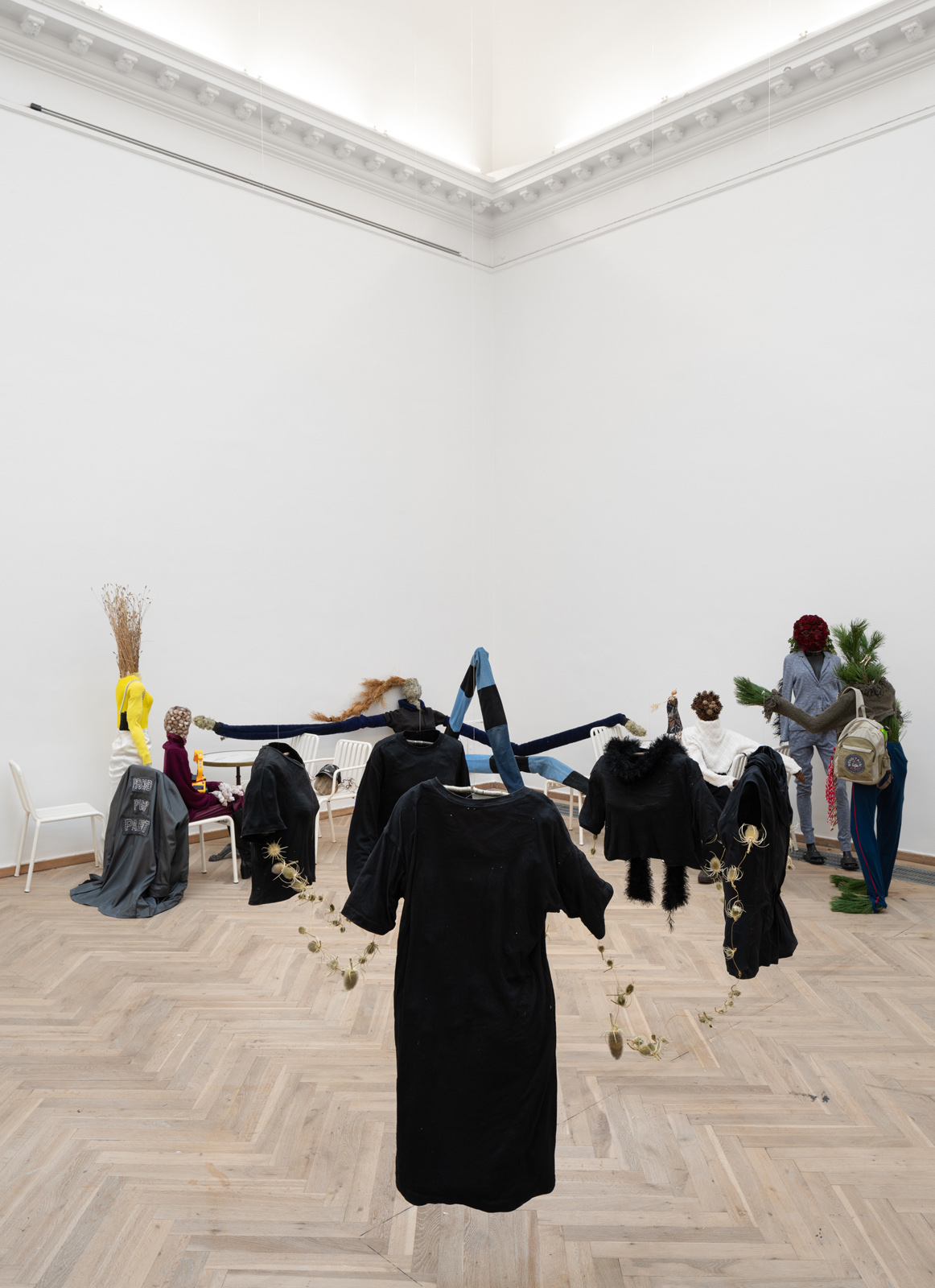
In the foreground
Elves [Elverpiger], 2020
Dried Fuller's teasel [Karteboller], inox thread, cast shirts, fishing line, sticks, boa
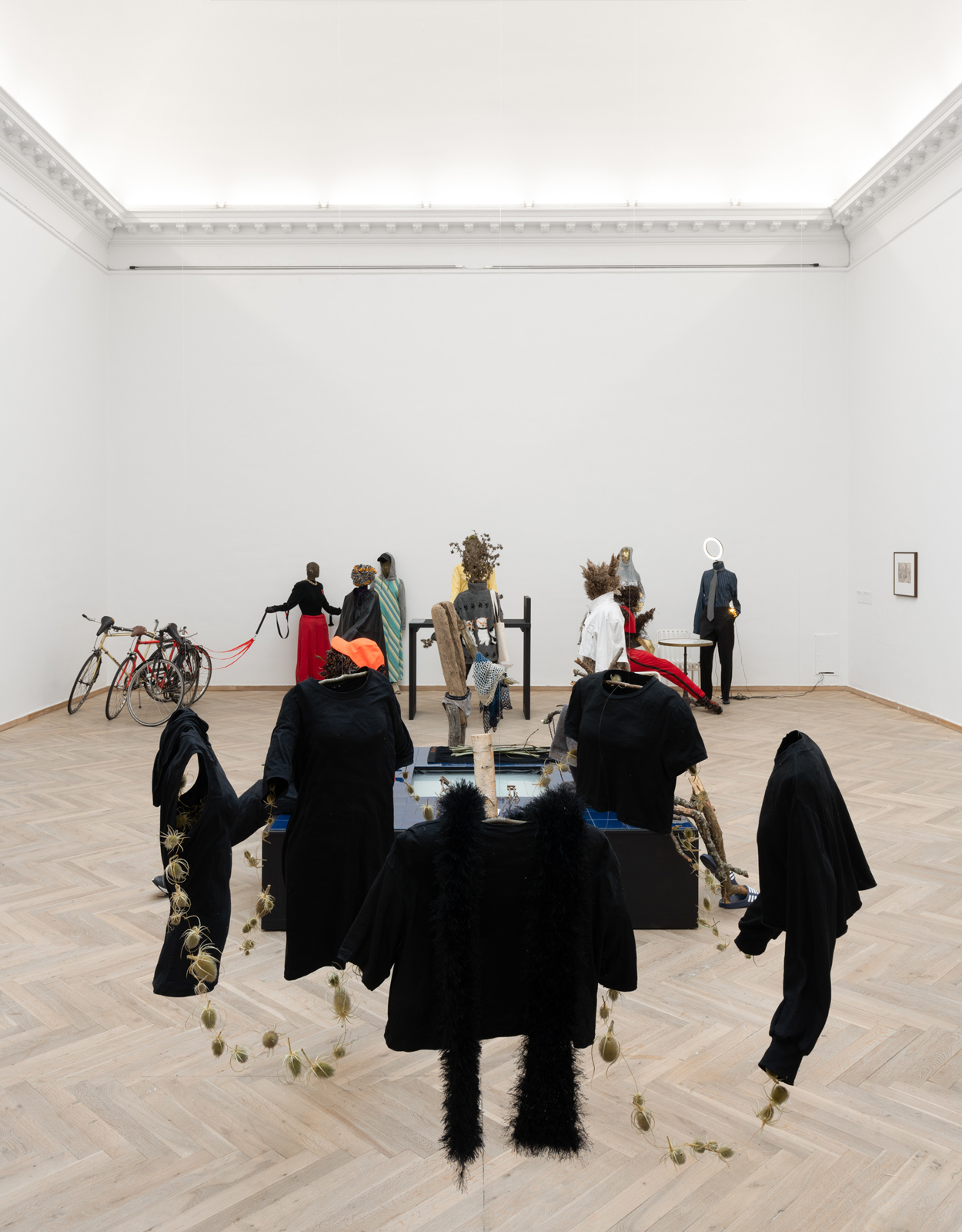
In the foreground
Elves [Elverpiger], 2020
Dried Fuller's teasel [Karteboller], inox thread, cast shirts, fishing line, sticks, boa
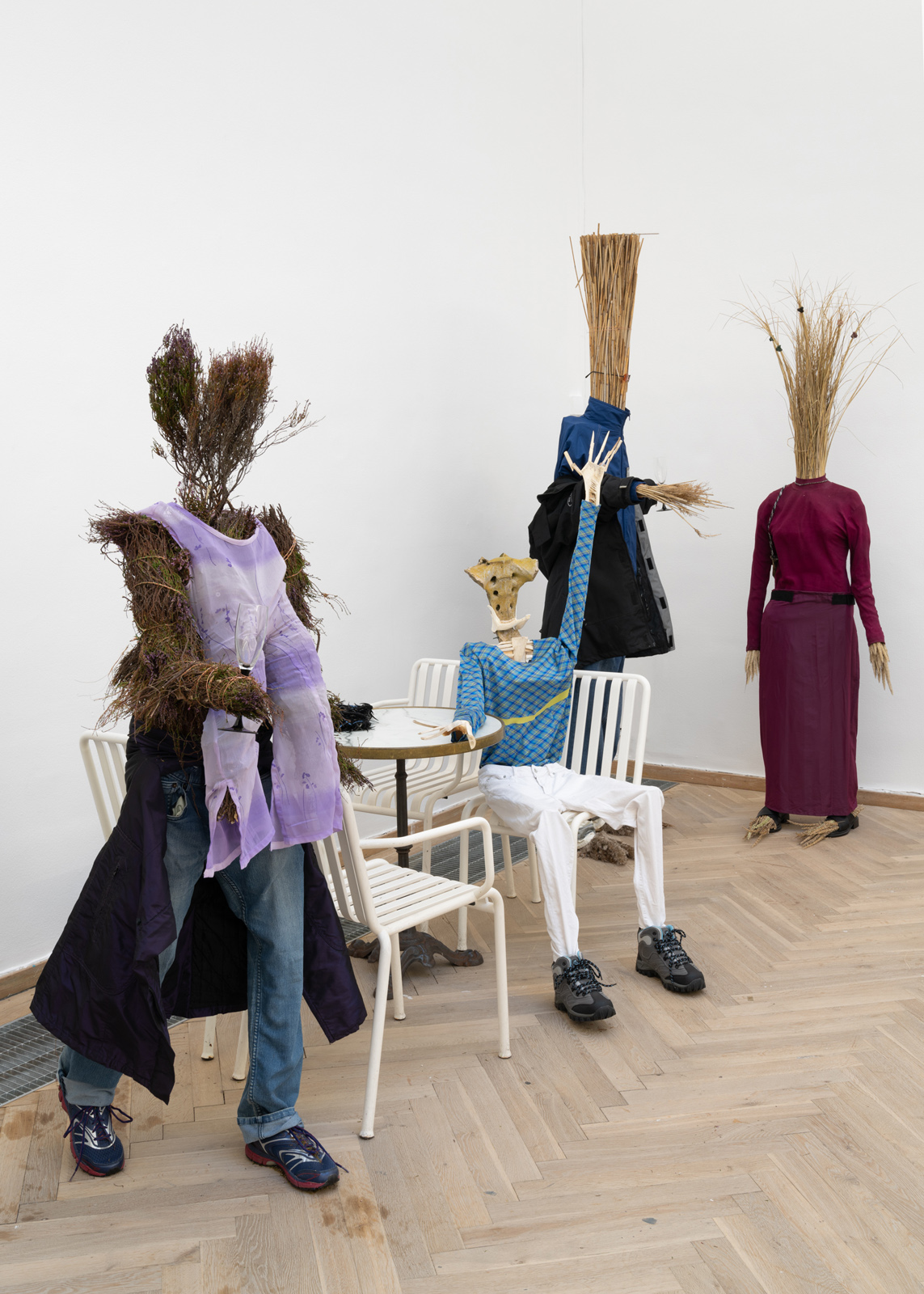
From left to right
Floppy Tits [Slattenpatten], 2020
Dried heather, wound metal and woolen thread, chiffon top, pants, jacket, shoes, wooden structure
Hild, 2020
Bones, ring, shirt, pants, shoes, wooden structure
The Nix [Åmanden], 2020
Reeds, reed flowers, copper thread, jacket, pullover, pants, glass, glasses, wooden structure
Mare, 2020
Lyme grass [Marehalm], cast shirt, skirt, shoes, lyme grass flowers, tote bag, hair clips
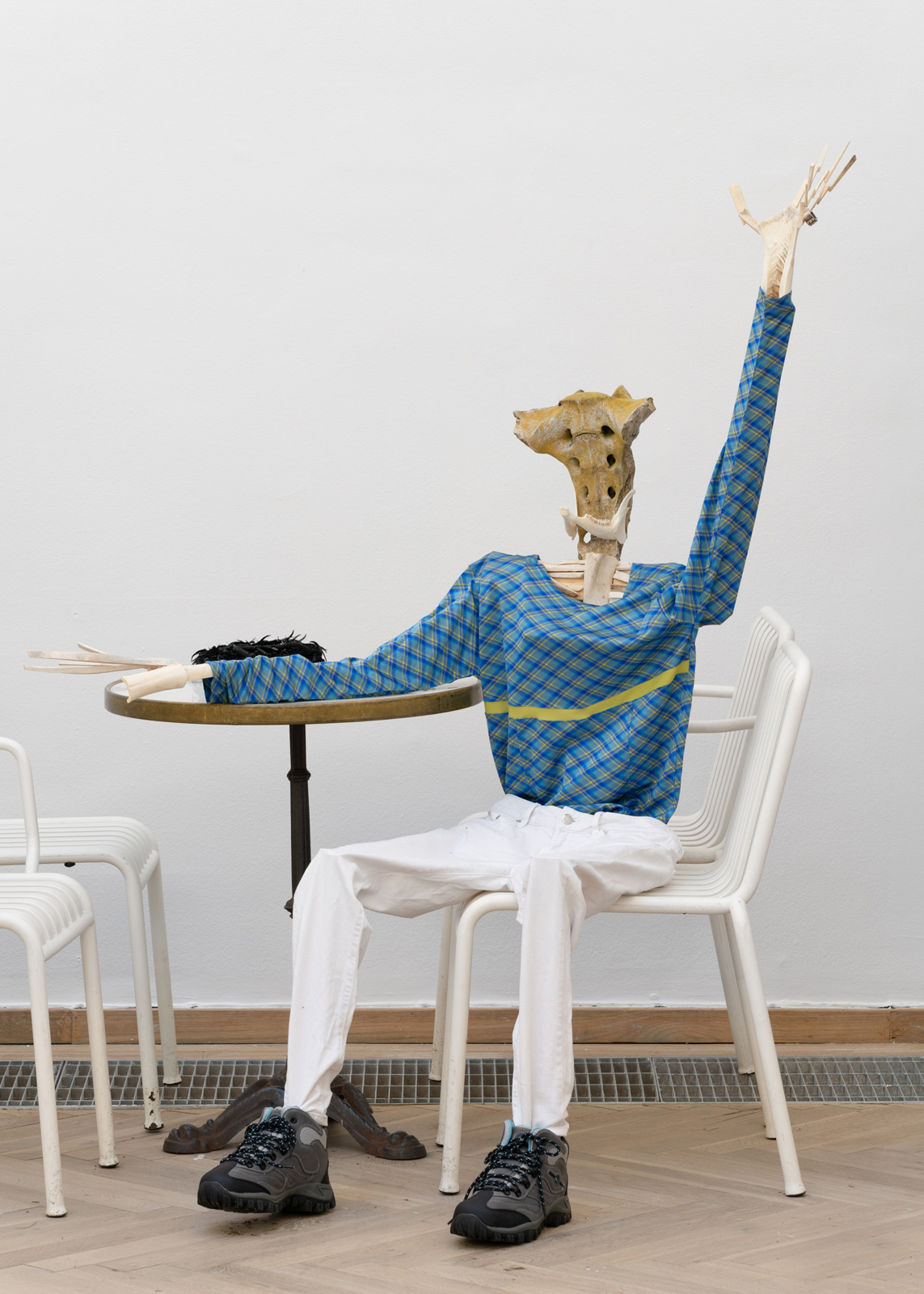
Hild, 2020
Bones, ring, shirt, pants, shoes, wooden structure
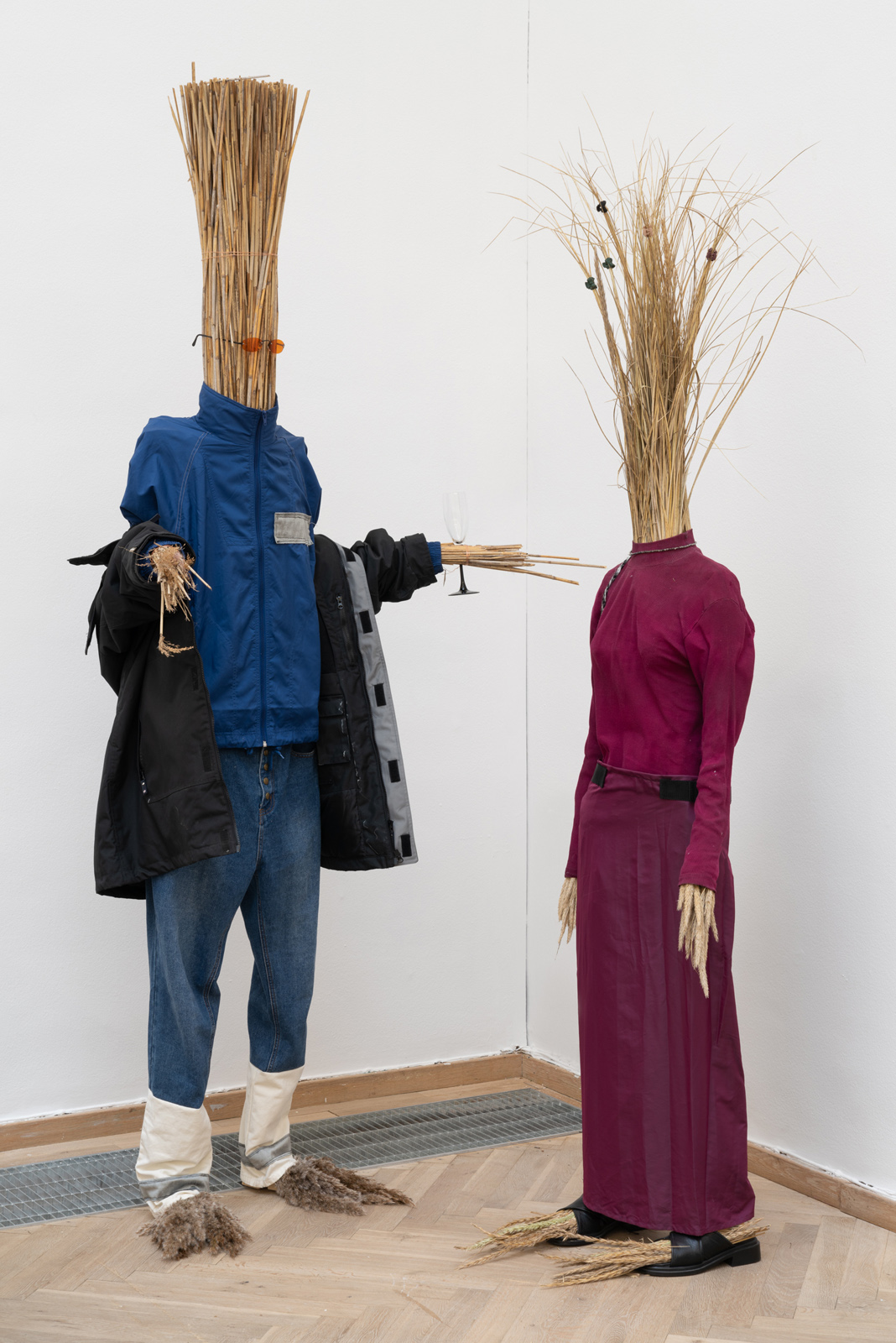
From left to right
The Nix [Åmanden], 2020
Reeds, reed flowers, copper thread, jacket, pullover, pants, glass, glasses, wooden structure
Mare, 2020
Lyme grass [Marehalm], cast shirt, skirt, shoes, lyme grass flowers, tote bag, hair clips
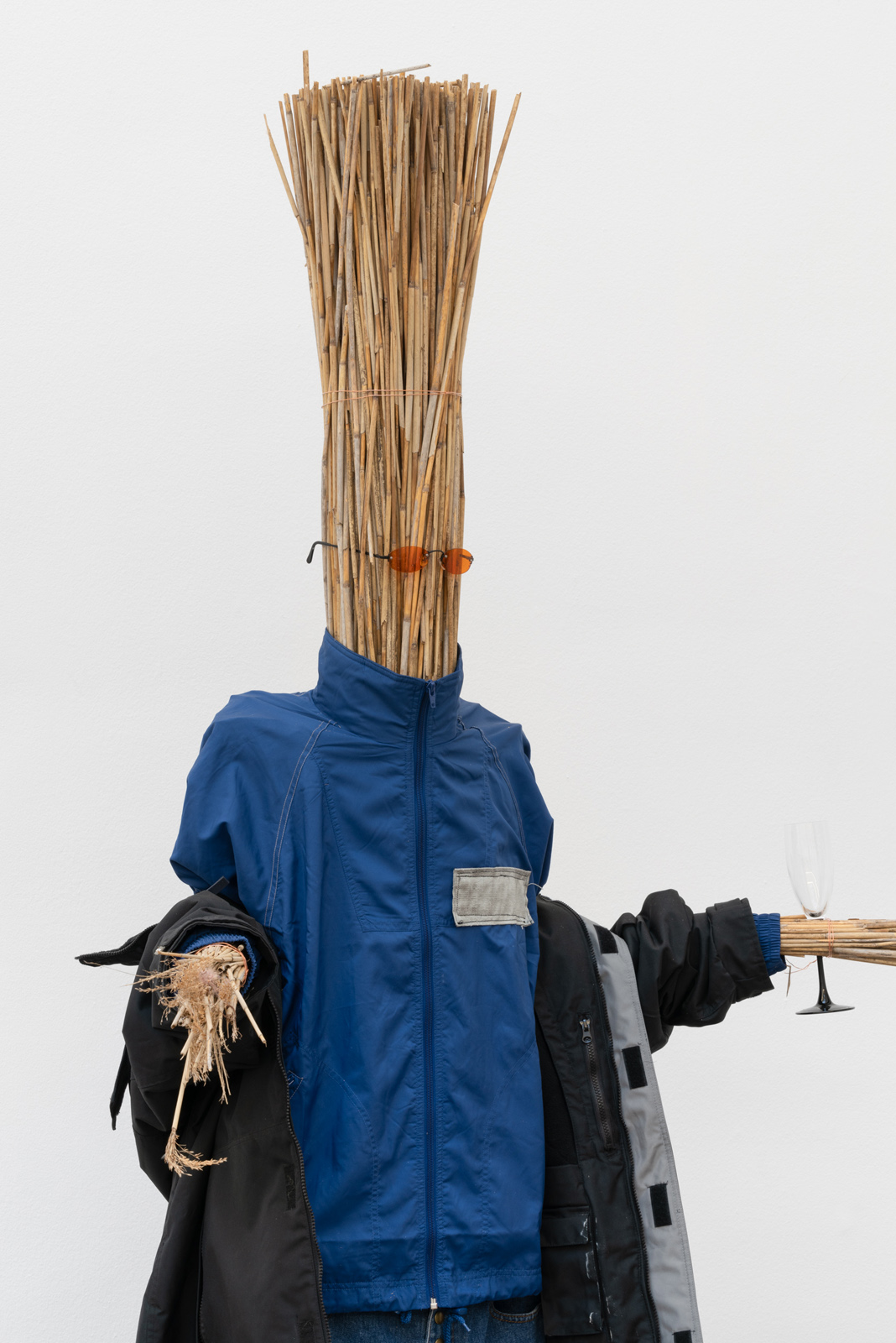
The Nix [Åmanden], 2020
Reeds, reed flowers, copper thread, jacket, pullover, pants, glass, glasses, wooden structure
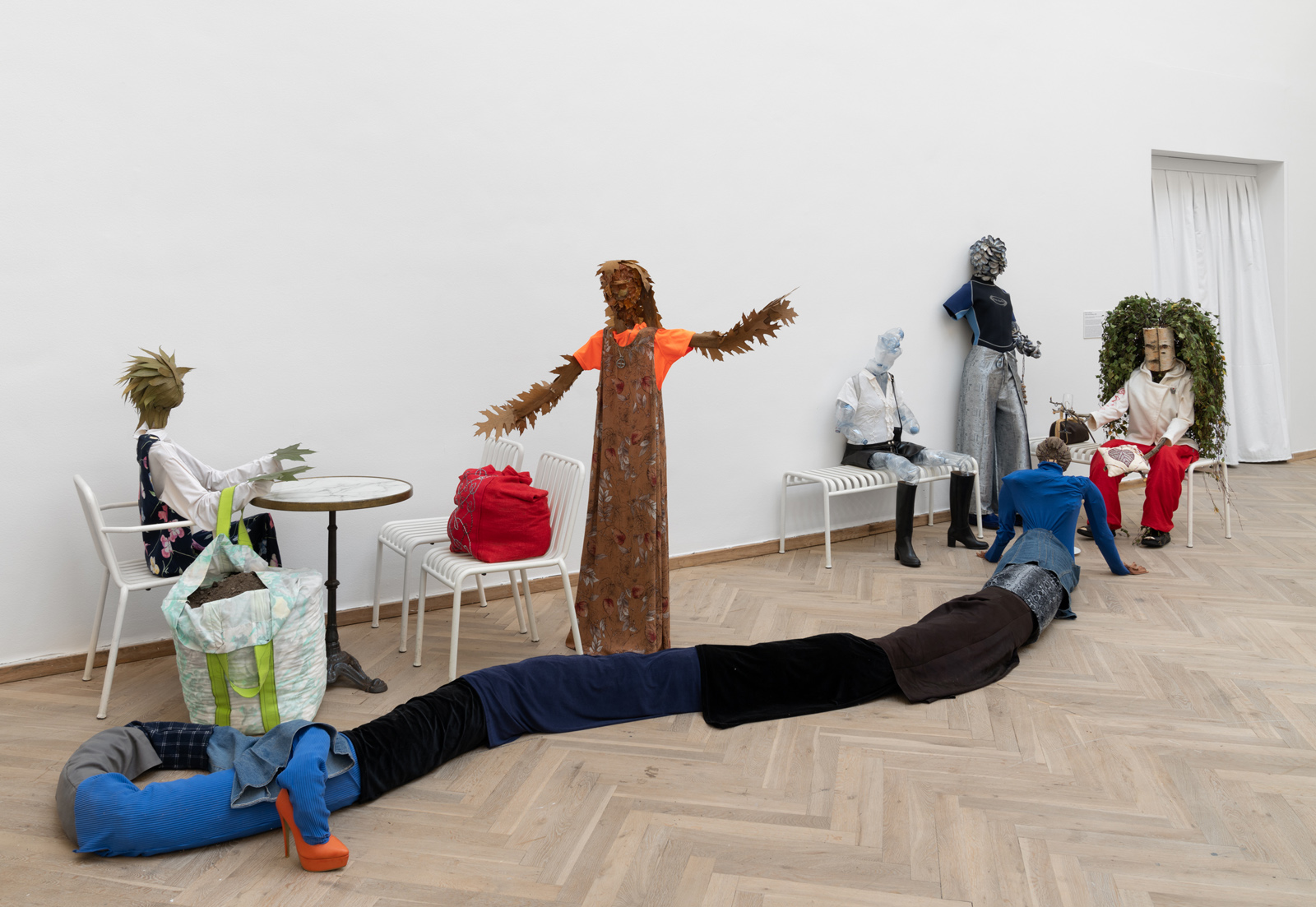
From left to right
Land Building Lady I [Landbygger Kvinde], 2020
Green dried leafs, silk dress, shirt, necklace, boots, tote bag filled with soil, wooden structure
Land Building Lady II [Landbygger Kvinde], 2020
Brown dried leafs, silk dress, shirt, necklace, boots, embroidered tote bag filled with soil, wooden structure
Lindworm [Lindorm], 2020
Foraged and proccessed soil from Kalvebod Fælled (DK), wound thread, clay, shirt, pine needles, wooden structure, narrowing skirts, foam, high heeled shoe, birtday candles, plate
Brookmaid [Kildefrue], 2020
Spring water bottles, plastic, copper thread, cast shirt, skirt, boots, bag
Agnete, 2020
Blue mussel shells, manneuin, scuba suit, silk pants, rubber boots, silver party horn, handbag
Mother Grib [Mor Grib], 2020
Birch trunks, birch branches, birch branches, embroidered hoodie, embroidered pillow, wound thread, pants, shoes, ring, glass wooden structure, bag

Land Building Lady I [Landbygger Kvinde], 2020
Green dried leafs, silk dress, shirt, necklace, boots, tote bag filled with soil, wooden structure
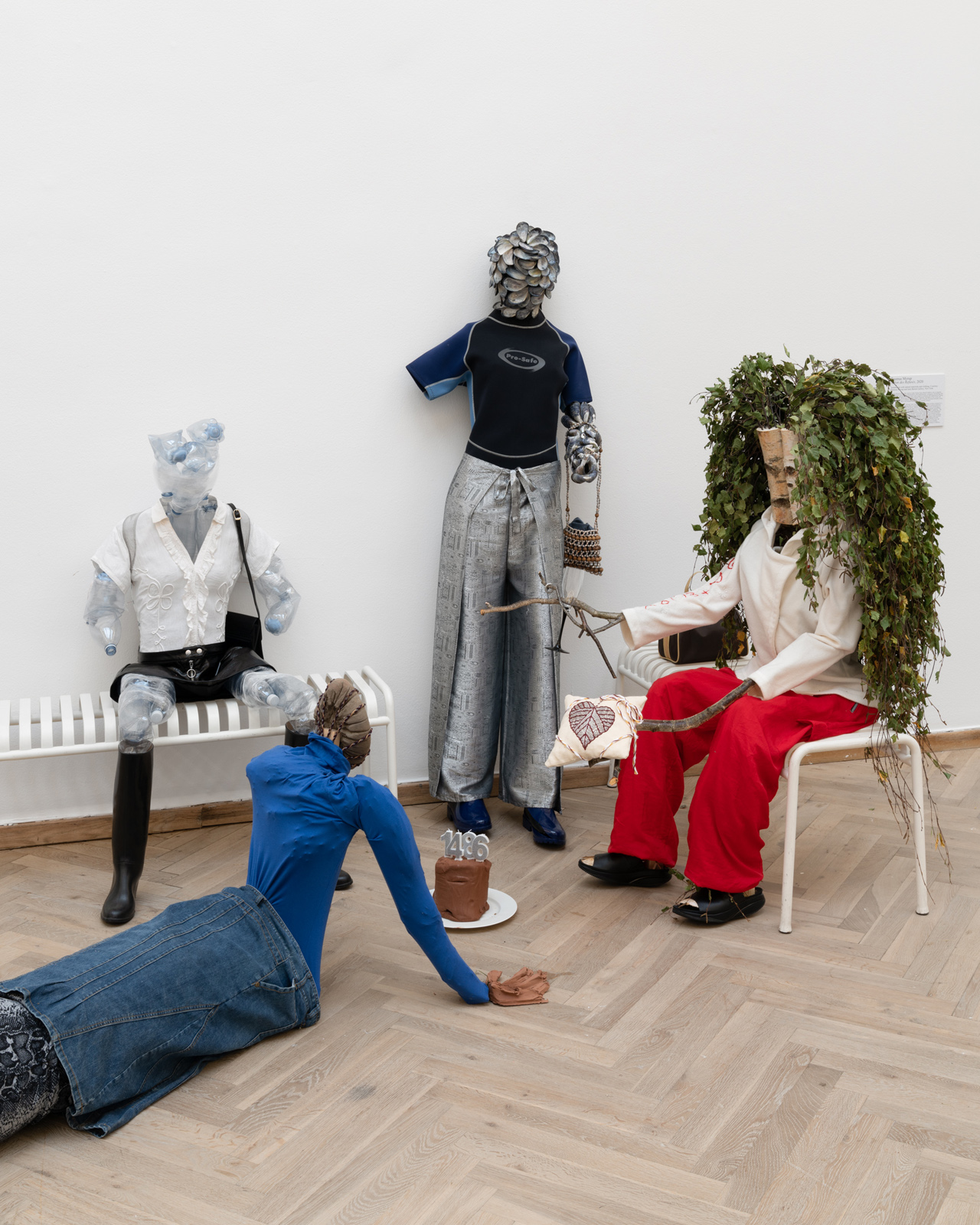
From left to right
Brookmaid [Kildefrue], 2020
Spring water bottles, plastic, copper thread, cast shirt, skirt, boots, bag
Lindworm [Lindorm], 2020
Foraged and proccessed soil from Kalvebod Fælled (DK), wound thread, clay, shirt, pine needles, wooden structure, narrowing skirts, foam, high heeled shoe, birtday candles, plate
Agnete, 2020
Blue mussel shells, manneuin, scuba suit, silk pants, rubber boots, silver party horn, handbag
Mother Grib [Mor Grib], 2020
Birch trunks, birch branches, birch branches, embroidered hoodie, embroidered pillow, wound thread, pants, shoes, ring, glass wooden structure, bag
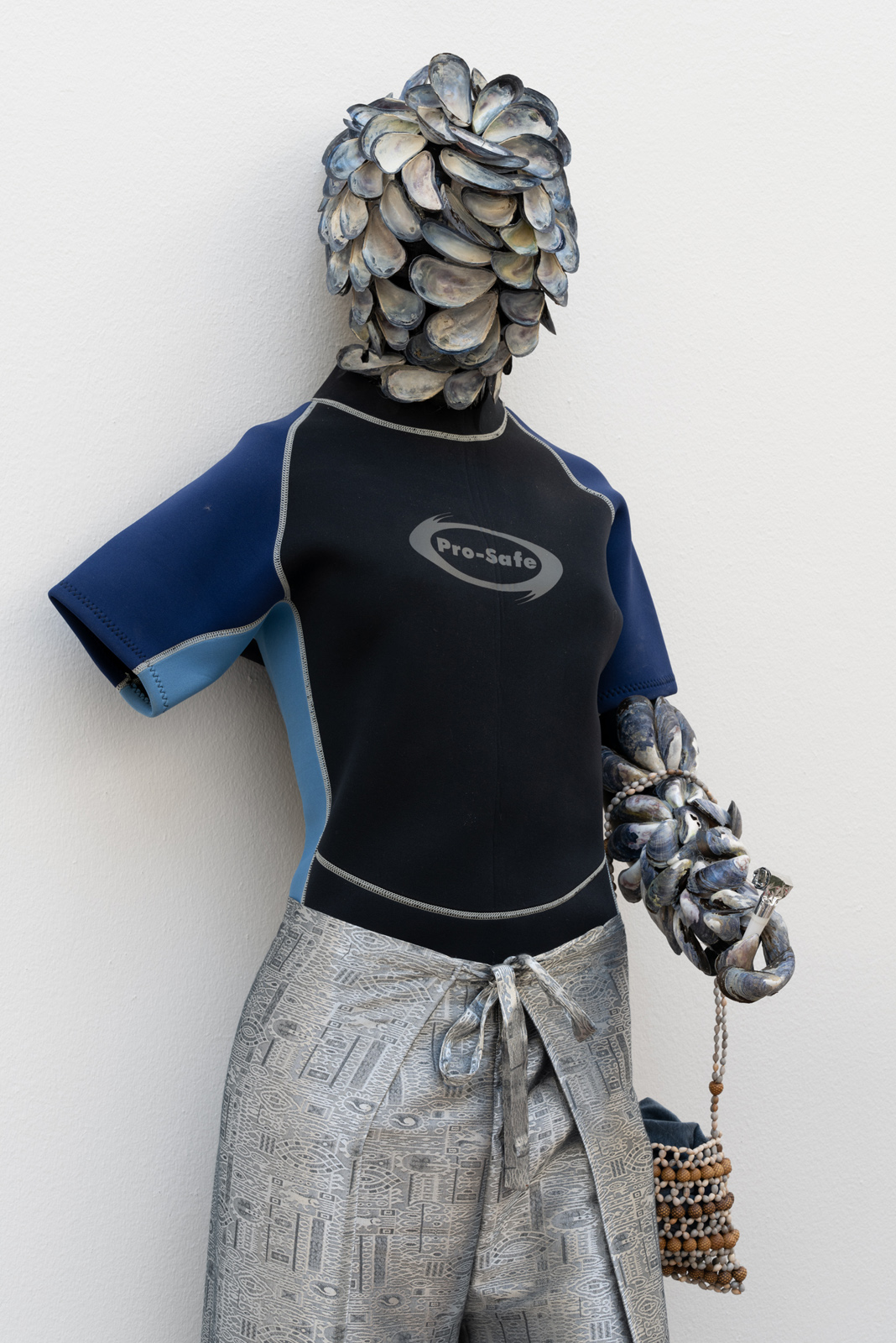
Agnete, 2020
Blue mussel shells, manneuin, scuba suit, silk pants, rubber boots, silver party horn, handbag
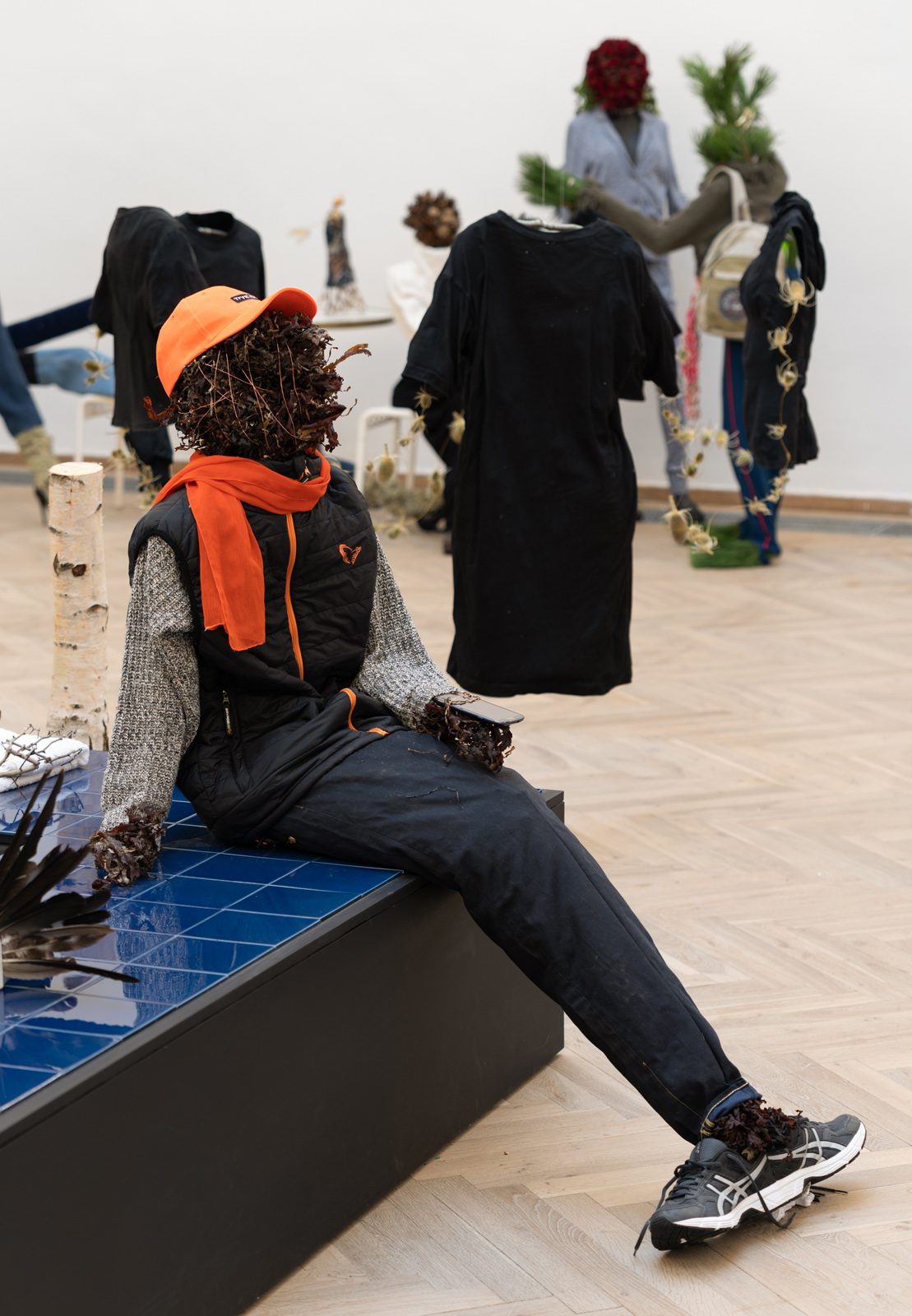
Merman [Havmand], 2020
Seaweed, copperwire, joint mermaid jeans, sweater, vest, cap, phone, joint mermaid sneaker, scarf, wooden structure, foam

Fjalar, 2020
Alarm clock, foraged feathers
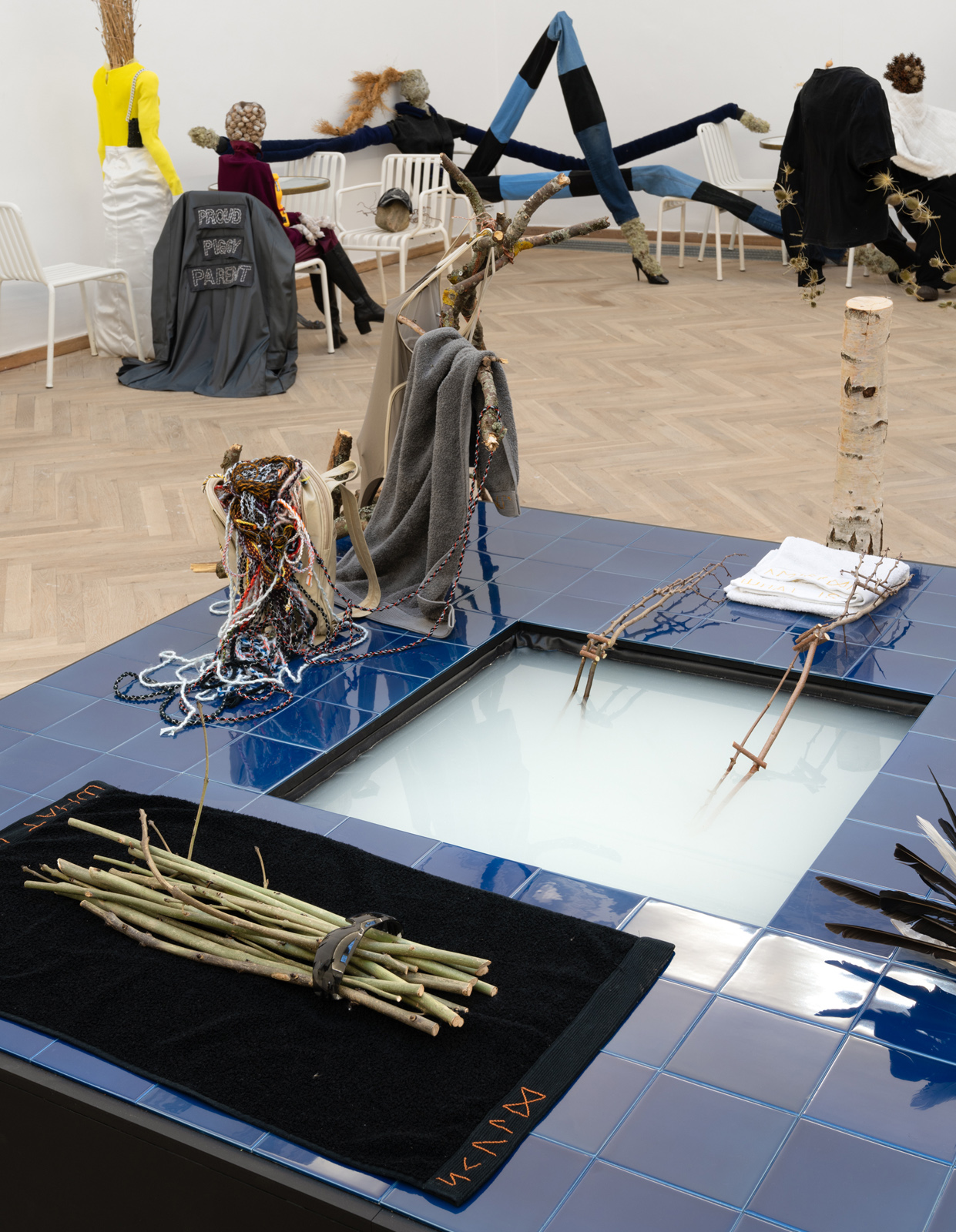
The Norns, Urdr [Urd], Verdandi [Verande] and Skuld, 2020
Embroidered towels, lichenridden oak branches, copper thread, swim suit, bag, wound ropes, slippers, hawthorn branches, birch trunk, high heel, ash wood, sunglasses
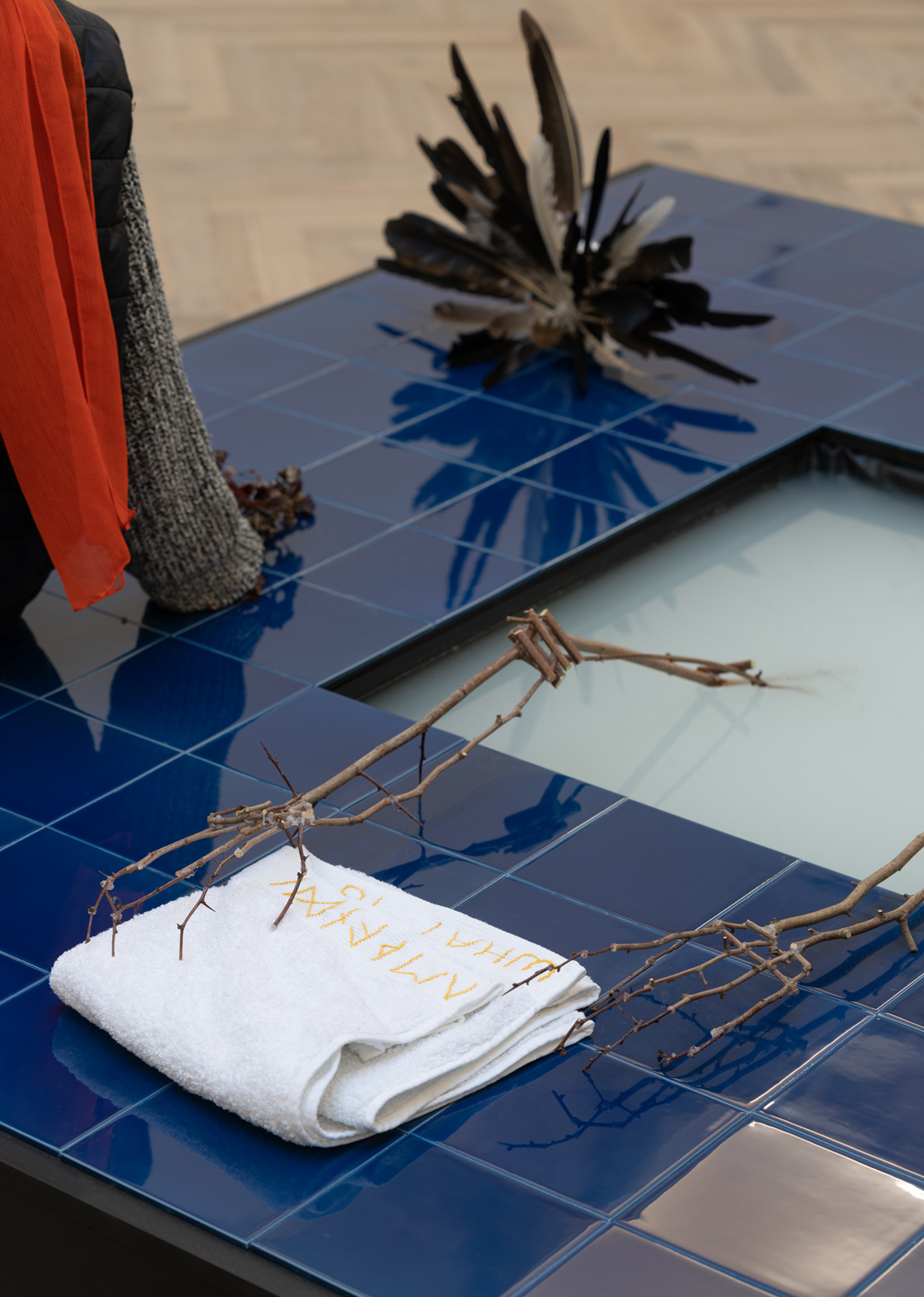
The Norn Verdandi [Verande], 2020
Embroidered towel, hawthorn branches, birch trunk, high heel
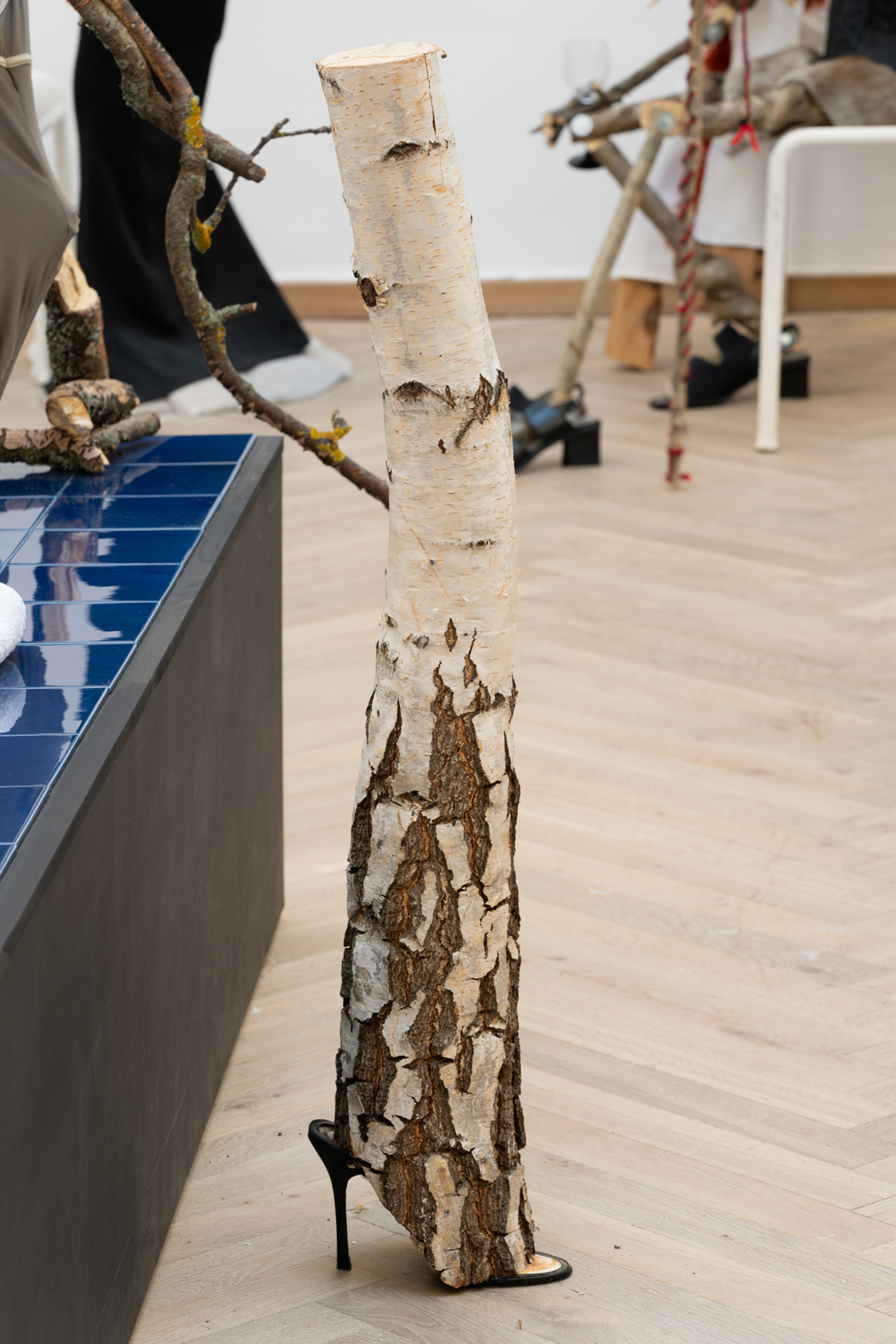
The Norn Verdandi [Verande], 2020
Embroidered towel, hawthorn branches, birch trunk, high heel
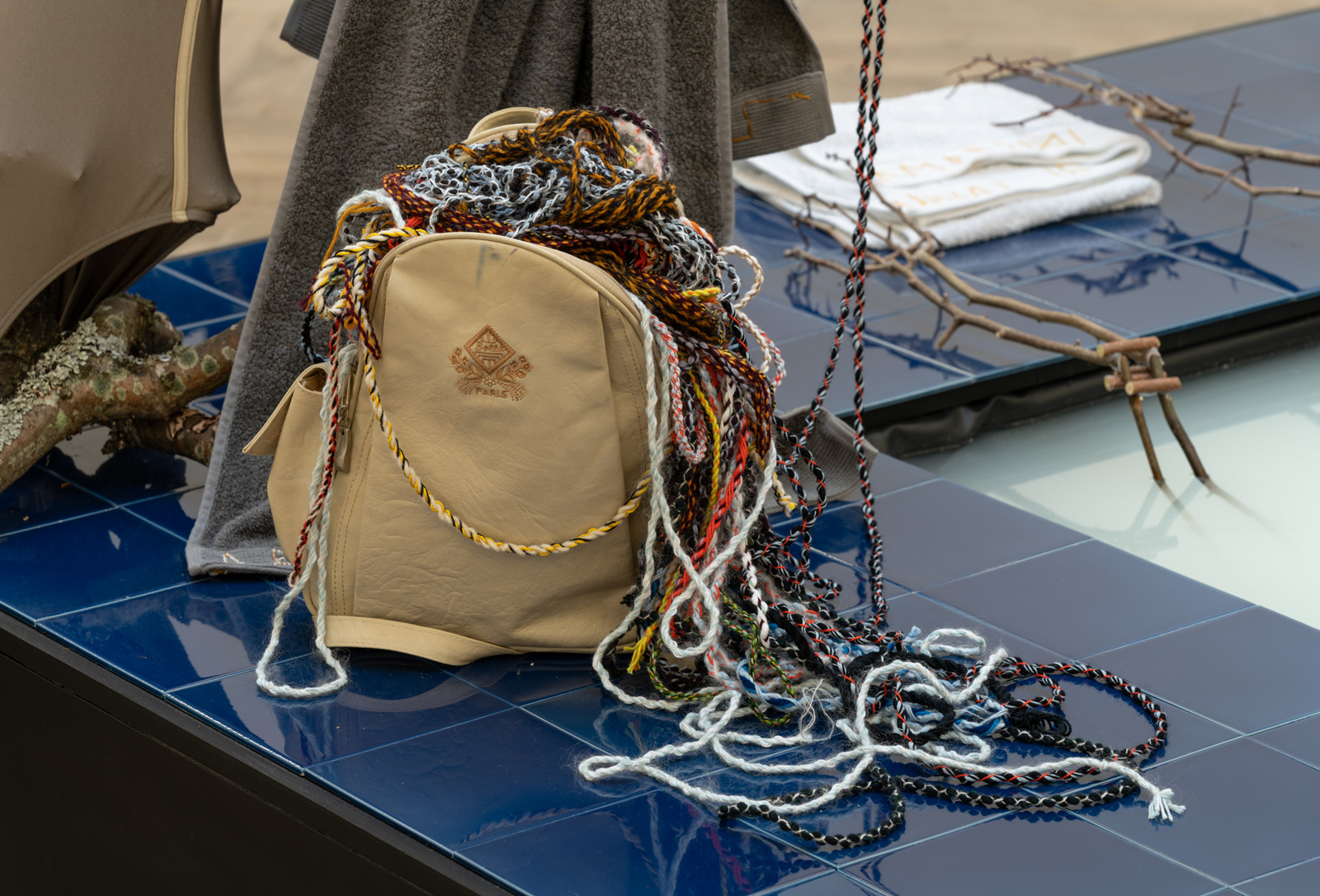
The Norn Urdr [Urd], 2020
Embroidered towel, lichenridden oak branches, copper thread, swim suit, bag, wound ropes, slippers
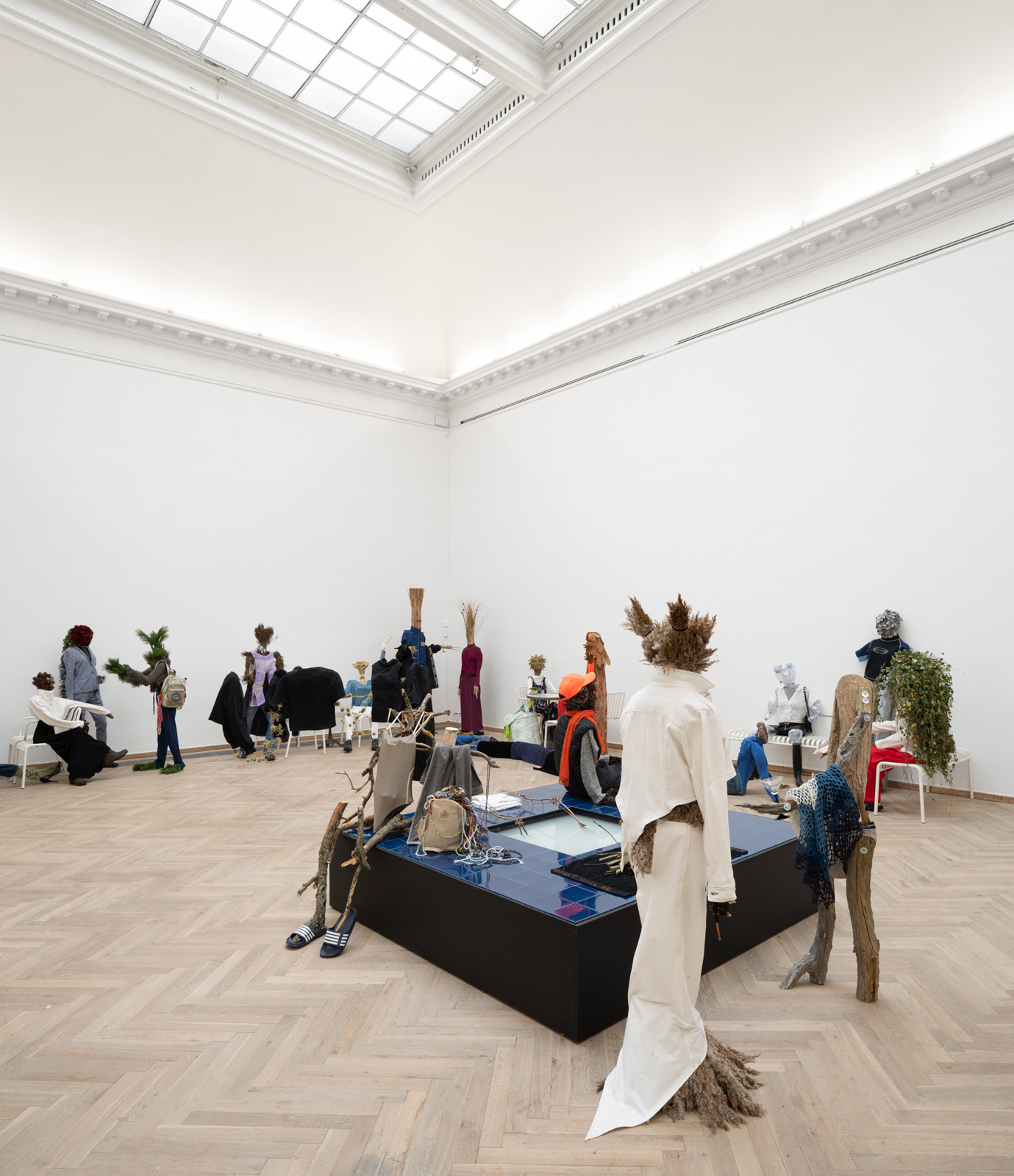
Salon des Refusés, 2020
Installation with clothes and natural materials
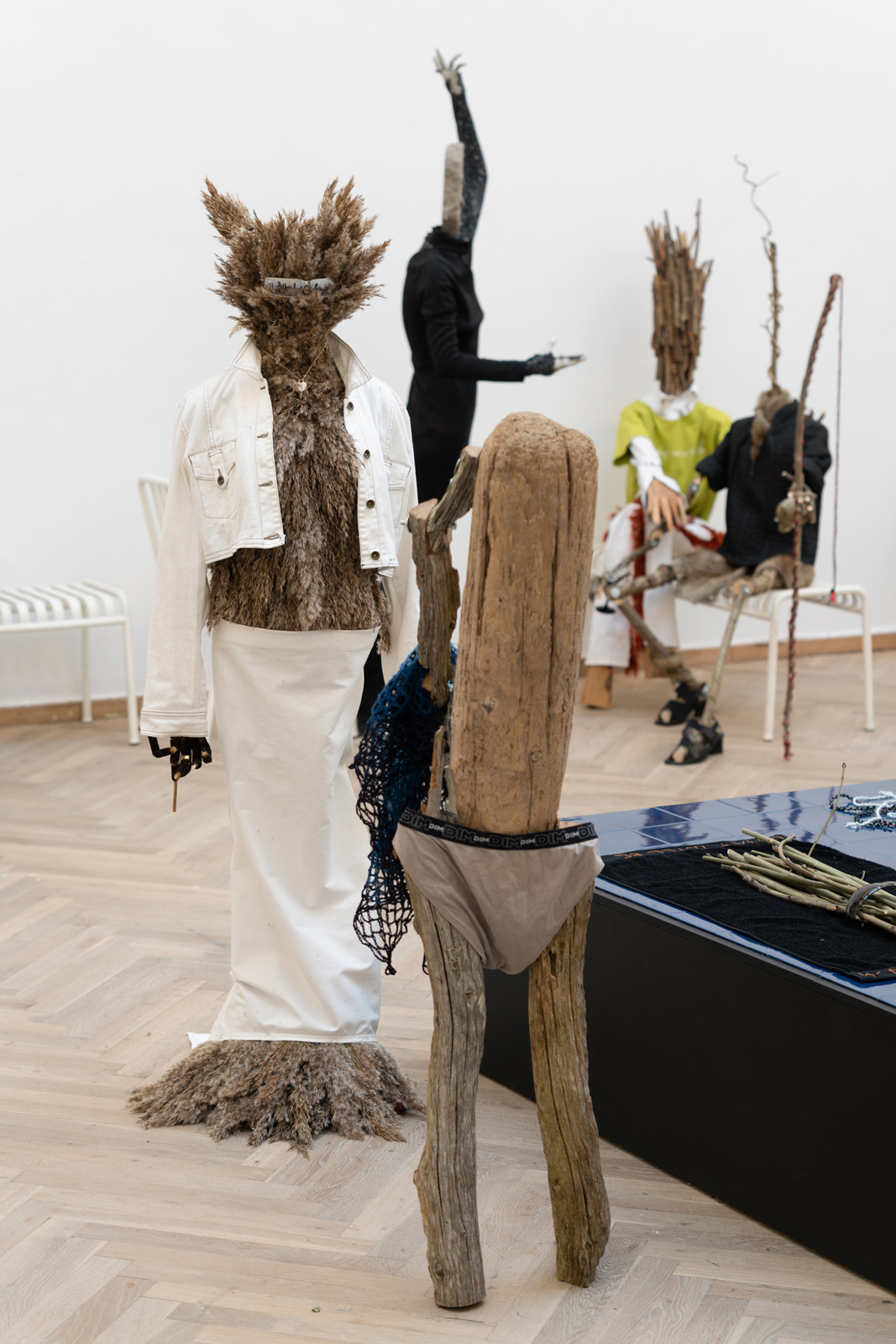
From left to right in the foreground
Virgin Poop [Jomfru Bæ], 2020
Reed flowers, cattails, mannequin, jacket, skirt, glasses, necklace, ring, copper wire
Beaced Body [Strandvasker], 2020
Driftwood, windswept oak from Gudhjem (DK), hardware, underwear, glass, blanket

Virgin Poop [Jomfru Bæ], 2020
Reed flowers, cattails, mannequin, jacket, skirt, glasses, necklace, ring, copper wire
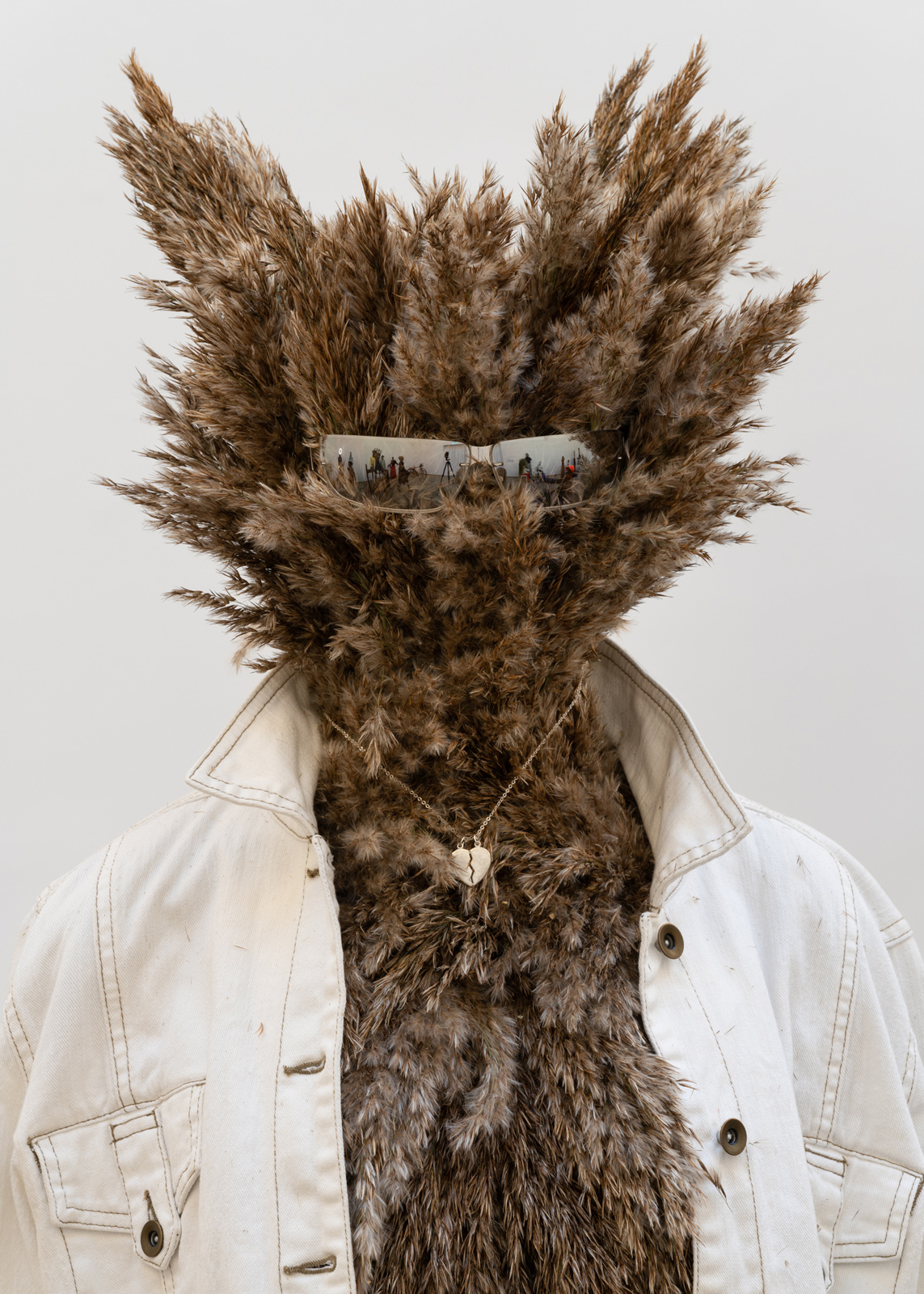
Virgin Poop [Jomfru Bæ], 2020
Reed flowers, cattails, mannequin, jacket, skirt, glasses, necklace, ring, copper wire
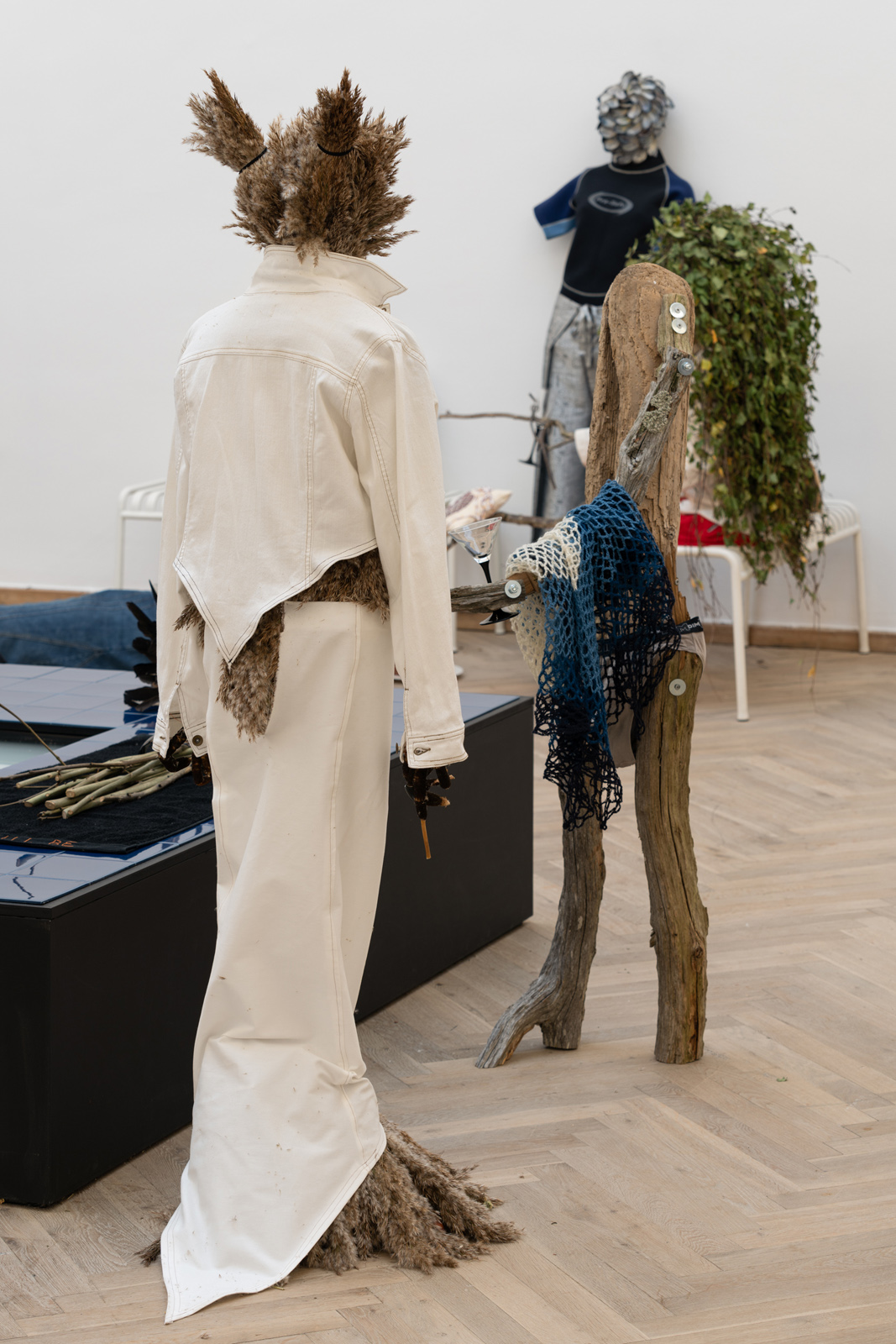
From left to right in the foreground
Beaced Body [Strandvasker], 2020
Driftwood, windswept oak from Gudhjem (DK), hardware, underwear, glass, blanket
Virgin Poop [Jomfru Bæ], 2020
Reed flowers, cattails, mannequin, jacket, skirt, glasses, necklace, ring, copper wire
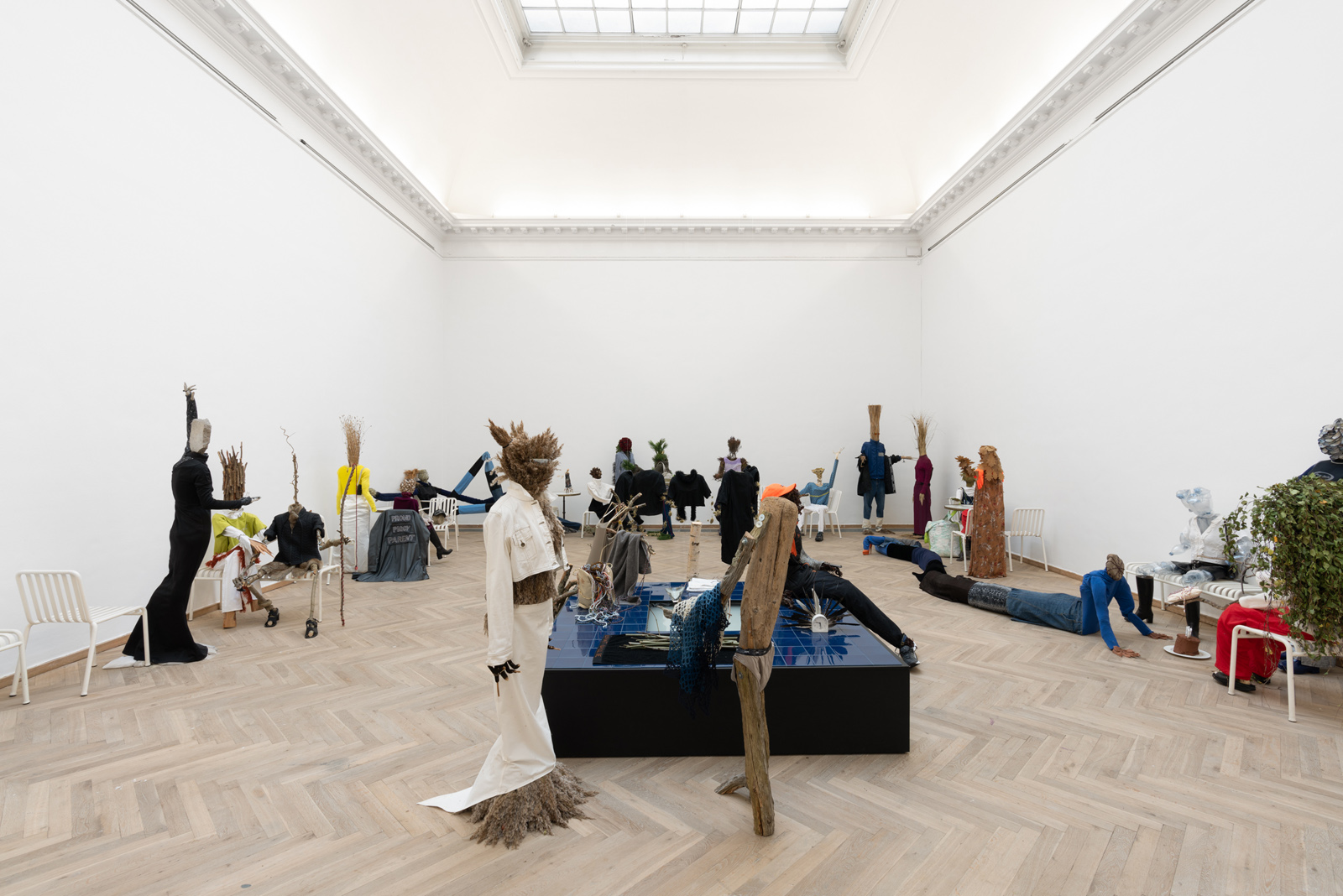
Salon des Refusés, 2020
Installation with clothes and natural materials